A new improved optimization of perturbation theory applications to the oscillator energy le
- 格式:pdf
- 大小:227.37 KB
- 文档页数:9
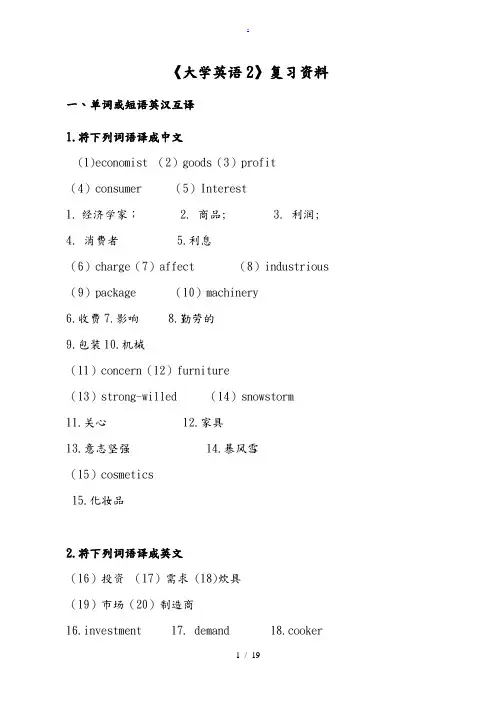
《大学英语2》复习资料一、单词或短语英汉互译1.将下列词语译成中文(1)economist (2)goods(3)profit(4)consumer (5)Interest1.经济学家;2. 商品;3. 利润;4. 消费者5.利息(6)charge(7)affect (8)industrious(9)package (10)machinery6.收费7.影响8.勤劳的9.包装10.机械(11)concern(12)furniture(13)strong-willed (14)snowstorm11.关心 12.家具13.意志坚强 14.暴风雪(15)cosmetics15.化妆品2.将下列词语译成英文(16)投资(17)需求 (18)炊具(19)市场(20)制造商16.investment 17. demand 18.cooker19. Market20.manufacturer(21)破坏 (22)受益(23)超过(24)进口(25)资源21.spoil 22.Benefit 23.Exceed24.Import25.resource(26)条形码(27)结账(28)以防万一26.universal product code 27.check out28.In case(29)气候(30)免费29.climate 30.Free二、单项选择题1. Apparently, it wasn't an accident.Someone must have done it on( B ).A.intentionB.determinationC.purposeD.reason2.The young doctor could not sleep at night, the worsening condition of a patient( A )him.A.disturbingB.disturbedC.being disturbedD.to disturb3. ( D ) Americans have different views on many issues,they tend to agree on one subject: taxes are too high.A. DespiteB. In spite ofC. BecauseD. Although4. These little things aren't important( B ) themselves, but put together, they can cause troubles.A. byB. inC. forD. at5. If there were any inhabitants of the moon, they would see our earth reflecting the light of the sun,again like ahugemirror( C )in the sky.A. hangB. hangedC. hungD. hangs6. When we call a word “learned,” we do n ot mean that it is used by learned persons alone, ( C )simply that its presence in the English vocabulary is due to books and the cultivation of literature rather than to the actual needs of ordinary conversation.A. soB. sinceC. butD. for7. ( A )is accepted as true often is relatively, and not absolutely, true.A. WhatB. ThatC. WhichD. It8. I( D ) awake for about two hours last night.A. lieB. liedC. laidD. lay9. In theory, every person will have( B )to an unlimitedamount of information with the development of telecommunication satellites.A. entryB. accessC. entranceD. opening10. It is in Iran( A )the family members are involved in the wedding preparations.A. whereB. in whichC. thatD. from which11.The satellite also demonstrated how it could provide help to people living in isolated areas where( A )is difficult.A.transportationB.instructionC.applicationD. compensation12. As we have been very busy recently, we go to the theatre only( D ).A.absolutelyB.frequentlyC. ContinuallyD. occasionally13. We can come to the ( C ) that the more we practice, the more skillful we will be.A.traditionB.generationC.conclusionD. fact14. Since the road is wet this morning, last night( C ).A. it must be rainingB. it must rainC. it must have rainedD. it must have been rained15. A few years later, I found my hometown completely( A ).A. changedB. changingC. to be changedD. to change16. This novel is worthy of ( D ).A. readingB. readC. having readD. being read17. It is very kind ( C ) see me.A. from you toB. asC. as ifD. like that18. It looks ( C ) it‘s going to rain.A. thatB. asC. as ifD. like that19. The stone was so heavy that it was difficult for the old man to ( A ) it.A. liftB. reachC. riseD. touch20. They lives ( B ) the other side of the road.A. inB. onC. forD. by21. She can speak Japanese better than ( C )else.A. the oneB. no oneC. anyoneD. another22. This lesson is ( D ) than the last one.A. more easierB. more easyC. very easierD. much easier23. Today‘s weather isn’t as cold as it was yesterday,( B )?A. w asn’tB. is itC. was itD. isn’t it24. This book is for students ( D )native language is not English.A. of whomB. thatC. whichD. whose25.The sports meet has been ( A ) till next week because ofthe bad weather.A.put offB.put asideC.put upD.put down26. Either you or the headmaster( D ) the prize for these gifted students at the meeting.A. is handing inB. are to hand outC. are handing inD. is to hand out27. The teacher and writer( B ) asked to make a speech at the meeting.A. isB. wasC. areD. were28. Four-fifths of the workers here( C ) workers.A. is womanB. are womanC. are womenD. is women29. The rest of the food( D ) in the refrigerator.A. is to keepB. are to be keptC. are to keepD. is to be kept30. This room is much too hot; it’s like a ( D ).A. fantasyB. fossilC. fashionD. furnace31., I couldn't get a job in this company ( B )A.Try as I mightB.As I might tryC.Try though I mightD.I might try32.Contrarypopular belief, moderate exercise actually decreases your appetite( D )A.onB.atC.againstD.to33.When she worked with the government, shethe difficult task of monitoring elections( D )A.overworkedB.overtookC.underwentD.undertook34. I hope you will behigher spirits when we meet next time( D )A. toB. onC. ofD. in35. I'm wondering why he hasn't turnedat themeeting(B)A.downB.upC.outD.over36. It is a well-known facta person will move in a circle when hecannot use his eyes to control his direction( A )A.thatB.ifC.whenD.whether37., Mary went out with delight( B )A.With her homework doingB.With her homework doneC.Her homework was doneD.Done her homework38.the storm, we have to postpone the flight ( A )A.Owing toB.Thanks toC.BecauseD.As39. Tom's fatherhome until yesterday( D )A. doesn't writeB. don't write toC. didn't write toD. didn't write40. Are you sure you don't haveadvice to give me? I really need ( D )A. any; anyB. some; anyC. any; someD. any; some三、改错下列句子中有A,B,C,D 四个划底线部分,其中有一个是错误的,选出错误部分的字母,无需改正错误:1. My parents wanted make a scientist of me.A B C D2. He has a bad habit of interrupting others when they are speak.A B C D3. The room is beinga littlesmall; in addition it is so hot.A B C D4. I wish I had know her addressyesterday.A B C D5. The harder he studies, the greater progresses he’ll make.A B C D参考答案:1.B2.D3.B4.D5.B四、完形填空Insure means to protect _1_ a loss of money. Most people can budget their money so that their income will cover expected expenses _2_ food, clothing, housing, and public services. But, there is no way to know _3_ who will suffer a crisis (危机) such as a serious illness, fire, flood, or a car accident. Such crises usually _4_ great expense. Even if people could predict crises, it would be hard to save enough money to _5_ the expenses. Insurance is asystem _6_ a company collects money from many individuals and then pays certain expenses whenever one of those insured individuals is faced with a certain crisis. An insurance policy _7_ how much theinsurance costs and how much the company will pay when a policy holder is faced with a certain crisis. There are many different kinds of insurance, _8_ hospital, motor-car and fire. Insurance can be rather expensive but most people buy insurance of some kind. Insurance is something _9_ people buy and hope theywill _10_ need.1. A. for B. from C. against D. with2.A. such as B. for example C. that D. the same as3.A. predict B. ahead C. in advance D. earlier4.A. result from B. make C. take D.result in5.A. cover B. pay back C. fill D. make full6.A. that B. by which C. what D. where7. A. said B. agree C. make sure D. states8.A. include B. including C. as well as D. also9.A. which B. that C. as D. Like10.A. never B. ever C. sometimes D. often参考答案:1-5.CADCA 6-10.BDBBDWhy do some nations remain so much poorer than others?In a new study, economist Eli Berman of Boston University (1) ___B___ that part of the answer lies in the natrue of technologicalchange. (2) ___C__ the early 1960s, he notes, a small group of nations has made impressive progress. But on average, in the (3) ___A___ world per capita incomes have grown (4) ___D___ faster than those in advanced nations, which means the gap between the two has continued to (5) ___B___ in absolute terms.Berman points out that technological progress in recent decades has notably (6) __C___ on more educated work forces (7) ___D___ high levels of physical captial. Citing substantial research in the U. S. and (18) ___B___, attributing the widening wage gap between poorly-educated and well-educated workers to the (9) ___C___ demand for skilled labor generated by new technology, Berman theorized that nations with high levels of skilled workers should grow faster than (10) ___A___ with lower level of such resources.(1)A.proposes B.suggestsC.guaranteesplains(2)A.Up to B.DuringC.SinceD.In times of(3)A.developing B.developedC.developableD.developmental(4)A.not B.muchC.lessD.no(5)A.lengthen B.broadenC.deepenD.heighten(6)A.focused B.caughtC.dependedD.held(7)bining with B.suffering fromC.subjected toD.equipped with(8)A.anywhere B.elsewhereC.somewhereD.wherever(9)A.grown B.grown-upC.growingD.growing-up(10)A.those B.thatC.someD.any从所给词汇中为每空选一个适当的词。
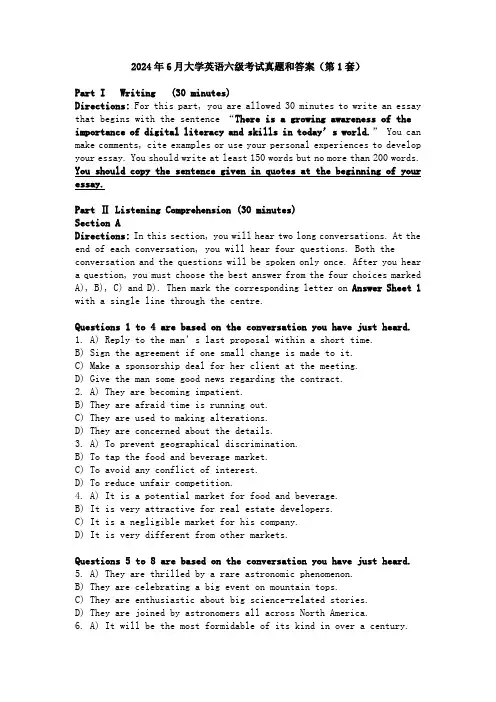
2024年6月大学英语六级考试真题和答案(第1套)Part I Writing (30 minutes)Directions: For this part, you are allowed 30 minutes to write an essay that begins with the sentence “There is a growing awareness of the importance of digital literacy and skills in today’s world.” You can make comments, cite examples or use your personal experiences to develop your essay. You should write at least 150 words but no more than 200 words. You should copy the sentence given in quotes at the beginning of your essay.Part Ⅱ Listening Comprehension (30 minutes)Section ADirections:In this section, you will hear two long conversations. At the end of each conversation, you will hear four questions. Both the conversation and the questions will be spoken only once. After you hear a question, you must choose the best answer from the four choices marked A), B), C) and D). Then mark the corresponding letter on Answer Sheet 1 with a single line through the centre.Questions 1 to 4 are based on the conversation you have just heard.1. A) Reply to the man’s last proposal within a short time.B) Sign the agreement if one small change is made to it.C) Make a sponsorship deal for her client at the meeting.D) Give the man some good news regarding the contract.2. A) They are becoming impatient.B) They are afraid time is running out.C) They are used to making alterations.D) They are concerned about the details.3. A) To prevent geographical discrimination.B) To tap the food and beverage market.C) To avoid any conflict of interest.D) To reduce unfair competition.4. A) It is a potential market for food and beverage.B) It is very attractive for real estate developers.C) It is a negligible market for his company.D) It is very different from other markets.Questions 5 to 8 are based on the conversation you have just heard.5. A) They are thrilled by a rare astronomic phenomenon.B) They are celebrating a big event on mountain tops.C) They are enthusiastic about big science-related stories.D) They are joined by astronomers all across North America.6. A) It will be the most formidable of its kind in over a century.B) It will come closest to Earth in more than one hundred years.C) It will eclipse many other such events in human history.D) It will be seen most clearly from Denver’s mountain tops.7. A) A blur.B) Stars.C) The edge of our galaxy.D) An ordinary flying object.8. A) Use professional equipment.B) Climb to the nearby heights.C) Fix their eyes due north.D) Make use of phone apps.Section BDirections: In this section, you will hear two passages. At the end of each passage, you will hear three or four questions. Both the passage and the questions will be spoken only once. After you hear a question, you must choose the best answer from the four choices marked A),B),C) and D). Then mark the corresponding letter on Answer Sheet 1 with a single line through the centre.Questions 9 to 11 are based on the passage you have just heard.9. A) Whether consumers should be warned against ultra-processed foods.B) Whether there is sufficient scientific consensus on dietary guidelines.C) Whether guidelines can form the basis for nutrition advice to consumers.D) Whether food scientists will agree on the concept of ultra-processed foods.10. A) By the labor cost for the final products.B) By the degree of industrial processing.C) By the extent of chemical alteration.D) By the convention of classification.11. A) Increased consumers’ expenses.B) Greater risk of chronic diseases.C) People’s misunderstanding of nutrition.D) Children’s dislike for unprocessed foods.Questions 12 to 15 are based on the passage you have just heard.12. A) They begin to think of the benefits of constraints.B) They try to seek solutions from creative people.C) They try hard to maximize their mental energy.D) They begin to see the world in a different way.13. A) It is characteristic of all creative people.B) It is essential to pushing society forward.C) It is a creative person’s response to limitation.D) It is an impetus to socio-economic development.14. A) Scarcity or abundance of resources has little impact on people’s creativity.B) Innovative people are not constrained in connecting unrelated concepts.C) People have no incentive to use available resources in new ways.D) Creative people tend to consume more available resources.15. A) It is key to a company’s survival.B) It shapes and focuses problems.C) It is essential to meeting challenges.D) It thrives best when constrained.Section CDirections: In this section, you will hear three recordings of lectures or talks followed by three or four questions. The recordings will be played only once. After you hear a question, you must choose the best answer from the four choices marked A), B), C) and D). Then mark the corresponding letter on Answer Sheet 1 with a single line through the centre.Questions 16 to 18 are based on the recording you have just heard.16. A) Because they are learned.B) Because they come naturally.C) Because they have to be properly personalized.D) Because there can be more effective strategies.17. A) The extent of difference and of similarity between the two sides.B) The knowledge of the specific expectation the other side holds.C) The importance of one’s goals and of the relationship.D) The approaches one adopts to conflict management.18. A) The fox.B) The owl.C) The shark.D) The turtle.Questions 19 to 21 are based on the recording you have just heard.19. A) Help save species from extinction and boost human health.B) Understand how plants and animals perished over the past.C) Help gather information publicly available to researchers.D) Find out the cause of extinction of Britain’s 66,000 species.20. A) It was once dominated by dinosaurs.B) It has entered the sixth mass extinction.C) Its prospects depend on future human behaviour.D) Its climate change is aggravated by humans.21. A) It dwarfs all other efforts to conserve, protect and restorebiodiversity on earth.B) It is costly to get started and requires the joint efforts of thousands of scientists.C) It can help to bring back the large numbers of plants and animals that have gone extinct.D) It is the most exciting, most relevant, most timely and most internationally inspirational.Questions 22 to 25 are based on the recording you have just heard.22. A) Cultural identity.B) Social evolution.C) The Copernican revolution.D) Human individuality.23. A) It is a delusion to be disposed of.B) It is prevalent even among academics.C) It is a myth spread by John Donne’s poem.D) It is rooted in the mindset of the 17th century.24. A) He believes in Copernican philosophical doctrines about the universe.B) He has gained ample scientific evidence at the University of Reading.C) He has found that our inner self and material self are interconnected.D) He contends most of our body cells can only live a few days or weeks.25. A) By coming to see how disruptive such problems have got to be.B) By realising that we all can do our own bit in such endeavours.C) By becoming aware that we are part of a bigger world.D) By making joint efforts resolutely and persistently.Part III Reading Comprehension (40 minutes)Section ADirections: In this section, there is a passage with ten blanks. You are required to select one word for each blank from a list of choices given in a word bank following the passage. Read the passage through carefully before making your choices. Each choice in the bank is identified by a letter. Please mark the corresponding letter for each item on Answer Sheet 2with a single line through the centre. You may not use any of the words in the bank more than once.It’s quite remarkable how different genres of music can spark unique feelings, emotions, and memories. Studies have shown that music can reduce stress and anxiety before surgeries and we are all attracted toward our own unique life soundtrack.If you’re looking to____26____stress, you might want to give classical music a try.The sounds of classical music produce a calming effectletting____27____pleasure-inducing dopamine (多巴胺) in the brain thathelps control attention, learning and emotional responses.It can also turn down the body’s stress response, resulting in an overall happier mood. It turns out a pleasant mood can lead to____28____in a person’s thinking.Although there are many great____29____of classical music like Bach, Beethoven and Handel, none of these artists’ music seems to have the same health effects as Mozart’s does. According to researchers, listening to Mozart can increase brain wave activity and improve____30____function. Another study found that the distinctive features of Mozart’s music trigger parts of the brain that are responsible for high-level mental functions. Even maternity____31____use Mozart to help newborn babies adapt to life outside of the mother’s belly.It has been found that listening to classical music____32____reduces a person’s blood pressure. Researchers believe that the calming sounds of classical music may help your heart____33____from stress. Classical music can also be a great tool to help people who have trouble sleeping. One study found that students who had trouble sleeping slept better while they were listening to classical music.Whether classical music is something that you listen to on a regular basis or not, it wouldn’t____34____to take time out of your day to listen to music that you find____35____. You will be surprised at how good it makes you feel and the potentially positive change in your health.A) alleviateB) clarityC) cognitiveD) composersE) hurtF) inhibitingG) interrogationH) intrinsicallyI) looseJ) majesticK) mandatoryL) recoverM) significantlyN) soothingO) wardsSection BDirections: In this section, you are going to read a passage with ten statements attached to it. Each statement contains information given in one of the paragraphs. Identify the paragraph from which the information is derived. You may choose a paragraph more than once. Each paragraph is marked with a letter. Answer the questions by marking the correspondingletter on Answer Sheet 2.The Curious Case of the Tree That Owns ItselfA) In the city of Athens, Georgia, there exists a rather curious local landmark—a large white oak that is almost universally stated to own itself. Because of this, it is considered one of the most famous trees in the world. So how did this tree come to own itself and the land around it?B) Sometime in the 19th century a Georgian called Colonel William Jackson reportedly took a liking to the said tree and endeavored to protect it from any danger. As to why he loved it so, the earliest documented account of this story is an anonymously written front page article in the Athens Weekly Banner published on August 12, 1890. It states, “Col. Jackson had watched the tree grow from his childhood, and grew to love it almost as he would a human. Its luxuriant leaves and sturdy limbs had often protected him from the heavy rains,and out of its highest branches he had many a time gotten the eggs of the feathered singers.He watched its growth, and when reaching a ripe old age he saw the tree standing in its magnificent proportions, he was pained to think that after his death it would fall into the hands of those who might destroy it.”C) Towards this end, Jackson transferred by means of a deed ownership of the tree and a little land around it to the tree itself. The deed read, “W. H. Jackson for and in consideration of the great affection which he bears the said tree, and his great desire to see it protected has conveyed unto the said oak tree entire possession of itself and of all land within eight feet of it on all sides.”D) In time, the tree came to be something of a tourist attraction, known as The Tree That Owns Itself. However, in the early 20th century, the tree started showing signs of its slow death,with little that could be done about it. Father time comes for us all eventually, even our often long lived, tall and leafy fellow custodians (看管者) of Earth. Finally, on October 9,1942, the over 30 meter tall and 200-400 year old tree fell, rumor has it, as a result of a severe windstorm and/or via having previously died and its roots rotted.E) About four years later, members of the Junior Ladies Garden Club (who’d tended to the tree before its unfortunate death) tracked down a small tree grown from a nut taken from the original tree. And so it was that on October 9, 1946, under the direction of Professor Roy Bowden of the College of Agriculture at the University of Georgia, this little tree was transplanted to the location of its ancestor. A couple of months later, an official ceremony was held featuring none other than the Mayor of Athens, Robert L McWhorter, to commemorate the occasion.F) This new tree became known as The Son of the Tree That Owns Itself and it was assumed that, as the original tree’s heir, it naturally inherited the land it stood on. Of course, there are many dozens of othertrees known to exist descending from the original, as people taking a nut from it to grow elsewhere was a certainty. Thatsaid, to date, none of the original tree’s other children have petitioned the courts for their share of the land, so it seems all good. In any event, The Son of the Tree That Owns Itself still stands today, though often referred to simply as The Tree That Owns Itself.G) This all brings us around to whether Jackson ever actually gave legal ownership of the tree to itself in the first place and whether such a deed is legally binding.H) Well, to begin with, it turns out Jackson only spent about three years of his life in Athens,starting at the age of 43 from 1829 to 1832, sort of dismissing the idea that he loved the tree from spending time under it as a child and watching it grow, and then worrying about what would happen to it after he died. Further, an extensive search of land ownership records in Athens does not seem to indicate Jackson ever owned the land the tree sits on.I) He did live on a lot of land directly next to it for those three years, but whether he owned that land or not isn’t clear. Whatever the case, in 1832 a four acre parcel, which included the land the tree was on and the neighboring land Jackson lived on, among others, was sold to University professor Malthus A Ward. In the transaction, Ward was required to pay Jackson a sum of $1,200 (about $31,000 today), either for the property itself or simply in compensation for improvements Jackson had made on the lot. In the end, whether he ever owned the neighboring lot or was simply allowed to use it while he allegedly worked at the University, he definitely never owned the lot the tree grew on, which is the most important bit for the topic at hand.J) After Professor Ward purchased the land, Jackson and his family purchased a 655 acre parcel a few miles away and moved there. Ten years later, in 1844, Jackson seemed to have come into financial difficulties and had his little plantation seized by the Clarke County Sheriff’s office and auctioned off to settle the mortgage. Thus, had he owned some land in Athens itself, including the land the tree sat on, presumably he would have sold it to raise funds or otherwise had it taken as well.K) And whatever the case there, Jackson would have known property taxes needed to be paid on the deeded land for the tree to be truly secure in its future. Yet no account or record indicates any trust or the like was set up to facilitate this.L) On top of all this, there is no hard evidence such a deed ever existed, despite the fact that deed records in Athens go back many decades before Jackson’s death in 1876 and that it was supposed to have existed in 1890 in the archives according to the original anonymous news reporter who claims to have seen it.M) As you might imagine from all of this, few give credit to this sideof the story. So how did all of this come about then?N) It is speculated to have been invented by the imagination of the said anonymous author at the Athens Weekly Banner in the aforementioned 1890 front page article titled “Deeded to Itself”, which by the way contained several elements that are much more easily proved to be false. As to why the author would do this, it’s speculated perhaps it was a 19th century version of a click-bait thought exercise on whether it would be legal for someone to deed such a non-conscious living thing to itself or not.O) Whatever the case, the next known instance of the Tree That Owns Itself being mentioned wasn’t until 1901 in the Centennial Edition of that same paper, the Athens Weekly Banner. This featured another account very clearly just copying the original article published about a decade before, only slightly reworded. The next account was in 1906, again in the Athens Weekly Banner, again very clearly copying the original account, only slightly reworded, the 19th century equivalent of re-posts when the audience has forgotten about the original.36. Jackson was said to have transferred his ownership of the oak tree to itself in order to protect it from being destroyed.37. No proof has been found from an extensive search that Jackson had ever owned the land where the oak tree grew.38. When it was raining heavily, Jackson often took shelter under a big tree that is said to own itself.39. There is no evidence that Jackson had made arrangements to pay property taxes for the land on which the oak tree sat.40. Professor Ward paid Jackson over one thousand dollars when purchasinga piece of land from him.41. It is said the tree that owned itself fell in a heavy windstorm.42. The story of the oak tree is suspected to have been invented as a thought exercise.43. Jackson’s little plantation was auctioned off to settle his debt in the mid-19th century.44. An official ceremony was held to celebrate the transplanting of a small tree to where its ancestor had stood.45. The story of the Tree That Owns Itself appeared in the local paper several times, with slight alterations in wording.Section CDirections:There are 2 passages in this section. Each passage is followed by some questions or unfinished statements. For each of them there are four choices marked A), B), C) and D). You should decide on the best choice and mark the corresponding letter on Answer Sheet 2 with a single line through the centre.Passage OneQuestions 46 to 50 are based on the following passage.It is irrefutable that employees know the difference between right and wrong. So why don’t more employees intervene when they see someone exhibiting at-risk behavior in the workplace?There are a number of factors that influence whether people intervene. First, they need to be able to see a risky situation beginning to unfold. Second, the company’s culture needs to make them feel safe to speak up. And third, they need to have the communication skills to say something effectively.This is not strictly a workplace problem; it’s a growing problem off the job too. Every day people witness things on the street and choose to stand idly by. This is known as the bystander effect—the more people who witness an event, the less likely anyone in that group is to help the victim. The psychology behind this is called diffusion of responsibility. Basically, the larger the crowd, the more people assume that someone else will take care of it—meaning no one effectively intervenes or acts in a moment of need.This crowd mentality is strong enough for people to evade their known responsibilities. But it’s not only frontline workers who don’t make safety interventions in the workplace. There are also instances where supervisors do not intervene either.When a group of employees sees unsafe behavior not being addressed at a leadership level it creates the precedent that this is how these situations should be addressed, thus defining the safety culture for everyone.Despite the fact that workers are encouraged to intervene when they observe unsafe operations, this happens less than half of the time. Fear is the ultimate factor in not intervening. There is a fear of penalty, a fear that they’ll have to do more work if they intervene. Unsuccessful attempts in the past are another strong contributing factor to why people don’t intervene—they tend to prefer to defer that action to someone else for all future situations.On many worksites, competent workers must be appointed. Part of their job is to intervene when workers perform a task without the proper equipment or if the conditions are unsafe. Competent workers are also required to stop work from continuing when there’s a danger.Supervisors also play a critical role. Even if a competent person isn’t required, supervisors need a broad set of skills to not only identify and alleviate workplace hazards but also build a safety climate within their team that supports intervening and open communication among them.Beyond competent workers and supervisors, it’s important to educate everyone within the organization that they are obliged to intervene ifthey witness a possible unsafe act, whether you’re a designated competent person, a supervisor or a frontline worker.46. What is one of the factors contributing to failure of intervention in face of risky behavior in the workplace?A) Slack supervision style.B) Unfavorable workplace culture.C) Unforeseeable risk.D) Blocked communication.47. What does the author mean by “diffusion of responsibility” (Line 4, Para. 3)?A) The more people are around, the more they need to worry about their personal safety.B) The more people who witness an event, the less likely anyone will venture to participate.C) The more people idling around on the street, the more likely they need taking care of.D) The more people are around, the less chance someone will step forward to intervene.48. What happens when unsafe behavior at the workplace is not addressed by the leaders?A) No one will intervene when they see similar behaviors.B) Everyone will see it as the easiest way to deal with crisis.C) Workers have to take extra caution executing their duties.D) Workers are left to take care of the emergency themselves.49. What is the ultimate reason workers won’t act when they see unsafe operations?A) Preference of deferring the action to others.B) Anticipation of leadership intervention.C) Fear of being isolated by coworkers.D) Fear of having to do more work.50. What is critical to ensuring workplace safety?A) Workers be trained to operate their equipment properly.B) Workers exhibiting at-risk behavior be strictly disciplined.C) Supervisors create a safety environment for timely intervention.D) Supervisors conduct effective communication with frontline workers.Passage TwoQuestions 51 to 55 are based on the following passage.The term “environmentalist” can mean different things. It used to refer to people trying to protect wildlife and natural ecosystems. In the 21st century, the term has evolved to capture the need to combat human-made climate change.The distinction between these two strands of environmentalism is thecause of a split within the scientific community about nuclear energy.On one side are purists who believe nuclear power isn’t worth the risk and the exclusive solution to the climate crisis is renewable energy. The opposing side agrees that renewables are crucial, but says society needs an amount of power available to meet consumers’ basic demands when the sun isn’t shining and the wind isn’t blowing. Nuclear energy, being far cleaner than oil, gas and coal, is a natural option, especially where hydroelectric capacity is limited.Leon Clarke, who helped author reports for the UN’s Intergovernmental Panel on Climate Change, isn’t an uncritical supporter of nuclear energy, but says it’s a valuable option to have if we’re serious about reaching carbon neutrality.“Core to all of this is the degree to which you think we can actually meet climate goals with 100% renewables,” he said. “If you don’t believe we can do it, and you care about the climate, you are forced to think about something like nuclear.”The achievability of universal 100% renewability is similarly contentious. Cities such as Burlington, Vermont, have been “100% renewable” for years. But these cities often have small populations, occasionally still rely on fossil fuel energy and have significant renewable resources at their immediate disposal. Meanwhile, countries that manage to run off renewables typically do so thanks to extraordinary hydroelectric capabilities.Germany stands as the best case study for a large, industrialized country pushing into green energy. Chancellor Angela Merkel in 2011 announced Energiewende, an energy transition that would phase out nuclear and coal while phasing in renewables. Wind and solar power generation has increased over 400% since 2010, and renewables provided 46% of the country’s electricity in 2019.But progress has halted in recent years. The instability of renewables doesn’t just mean energy is often not produced at night, but also that solar and wind can overwhelm the grid during the day, forcing utilities to pay customers to use their electricity. Lagging grid infrastructure struggles to transport this overabundance of green energy from Germany’s north to its industrial south, meaning many factories still run on coal and gas. The political limit has also been reached in some places, with citizens meeting the construction of new wind turbines with loud protests.The result is that Germany’s greenhouse gas emissions have fallen by around 11.5% since 2010—slower than the EU average of 13.5%.51. What accounts for the divide within the scientific community about nuclear energy?A) Attention to combating human-made climate change.B) Emphasis on protecting wildlife and natural ecosystems.C) Evolution of the term ‘green energy’ over the last century.D) Adherence to different interpretations of environmentalism.52. What is the solution to energy shortage proposed by purists’opponents?A) Relying on renewables firmly and exclusively.B) Using fossil fuel and green energy alternately.C) Opting for nuclear energy when necessary.D) Limiting people’s non-basic consumption.53. What point does the author want to make with cities like Burlington as an example?A) It is controversial whether the goal of the whole world’s exclusive dependence on renewables is attainable.B) It is contentious whether cities with large populations have renewable resources at their immediate disposal.C) It is arguable whether cities that manage to run off renewables have sustainable hydroelectric capabilities.D) It is debatable whether traditional fossil fuel energy can be done away with entirely throughout the world.54. What do we learn about Germany regarding renewable energy?A) It has increased its wind and solar power generation four times over the last two decades.B) It represents a good example of a major industrialized country promoting green energy.C) It relies on renewable energy to generate more than half of its electricity.D) It has succeeded in reaching the goal of energy transition set by Merkel.55. What may be one of the reasons for Germany’s progress having halted in recent years?A) Its grid infrastructure’s capacity has fallen behind its development of green energy.B) Its overabundance of green energy has forced power plants to suspend operation during daytime.C) Its industrial south is used to running factories on conventional energy supplies.D) Its renewable energy supplies are unstable both at night and during the day.Part IV Translation (30 minutes)Directions: For this part, you are allowed 30 minutes to translate a passage from Chinese into English. You should write your answer on Answer Sheet 2.中国的传统婚礼习俗历史悠久,从周朝开始就逐渐形成了一套完整的婚礼仪式,有些一直沿用至今。
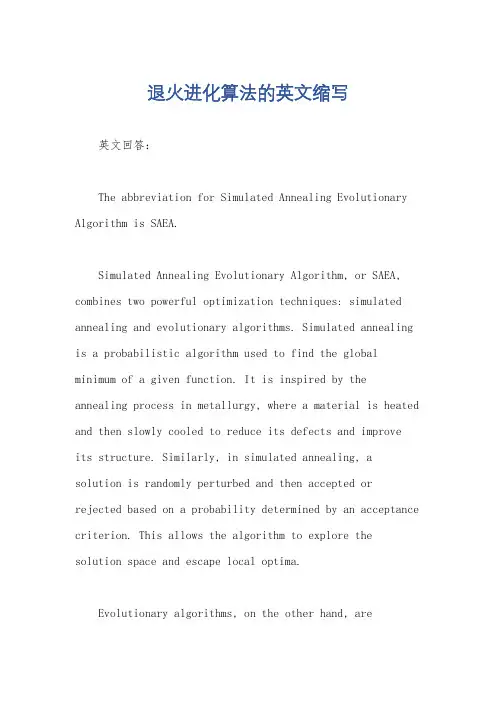
退火进化算法的英文缩写英文回答:The abbreviation for Simulated Annealing Evolutionary Algorithm is SAEA.Simulated Annealing Evolutionary Algorithm, or SAEA, combines two powerful optimization techniques: simulated annealing and evolutionary algorithms. Simulated annealing is a probabilistic algorithm used to find the global minimum of a given function. It is inspired by the annealing process in metallurgy, where a material is heated and then slowly cooled to reduce its defects and improveits structure. Similarly, in simulated annealing, asolution is randomly perturbed and then accepted or rejected based on a probability determined by an acceptance criterion. This allows the algorithm to explore thesolution space and escape local optima.Evolutionary algorithms, on the other hand, areinspired by the process of natural selection. They mimic the principles of evolution, such as mutation, crossover, and selection, to iteratively improve a population of candidate solutions. By applying these operators, the algorithm explores the search space and gradually converges towards better solutions.SAEA combines the strengths of simulated annealing and evolutionary algorithms to overcome their individual limitations. Simulated annealing provides the ability to escape local optima and explore the solution space, while evolutionary algorithms facilitate the convergence towards better solutions through the iterative improvement of a population. This synergy allows SAEA to efficiently search for optimal or near-optimal solutions in complex optimization problems.For example, let's consider the problem of finding the shortest path in a complex network. Using SAEA, we can represent each candidate solution as a sequence of nodes that defines a path through the network. The simulated annealing component allows the algorithm to exploredifferent paths by randomly perturbing the current solution and accepting or rejecting the new solution based on the acceptance criterion. The evolutionary component ensures that the algorithm converges towards better paths by applying mutation and crossover operators to the population of solutions. Through the iterative application of these operators, SAEA can find a near-optimal path that minimizes the distance traveled.In conclusion, the abbreviation for Simulated Annealing Evolutionary Algorithm is SAEA. This algorithm combines simulated annealing and evolutionary algorithms to efficiently search for optimal or near-optimal solutions in complex optimization problems. By leveraging the strengths of both techniques, SAEA can escape local optima, explore the solution space, and converge towards better solutions.。
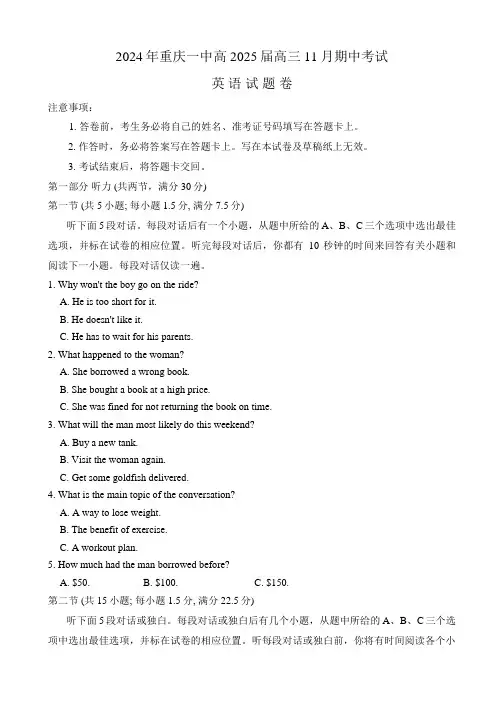
2024年重庆一中高2025届高三11月期中考试英语试题卷注意事项:1. 答卷前,考生务必将自己的姓名、准考证号码填写在答题卡上。
2. 作答时,务必将答案写在答题卡上。
写在本试卷及草稿纸上无效。
3. 考试结束后,将答题卡交回。
第一部分听力 (共两节,满分30分)第一节 (共5小题; 每小题1.5分, 满分7.5分)听下面5段对话。
每段对话后有一个小题,从题中所给的A、B、C三个选项中选出最佳选项,并标在试卷的相应位置。
听完每段对话后,你都有10秒钟的时间来回答有关小题和阅读下一小题。
每段对话仅读一遍。
1. Why won't the boy go on the ride?A. He is too short for it.B. He doesn't like it.C. He has to wait for his parents.2. What happened to the woman?A. She borrowed a wrong book.B. She bought a book at a high price.C. She was fined for not returning the book on time.3. What will the man most likely do this weekend?A. Buy a new tank.B. Visit the woman again.C. Get some goldfish delivered.4. What is the main topic of the conversation?A. A way to lose weight.B. The benefit of exercise.C. A workout plan.5. How much had the man borrowed before?A. $50.B. $100.C. $150.第二节 (共15小题; 每小题1.5分, 满分22.5分)听下面5段对话或独白。
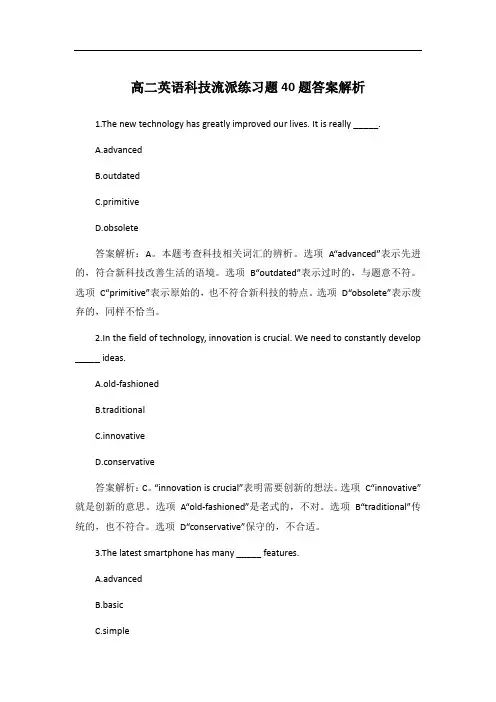
高二英语科技流派练习题40题答案解析1.The new technology has greatly improved our lives. It is really _____.A.advancedB.outdatedC.primitiveD.obsolete答案解析:A。
本题考查科技相关词汇的辨析。
选项A“advanced”表示先进的,符合新科技改善生活的语境。
选项B“outdated”表示过时的,与题意不符。
选项C“primitive”表示原始的,也不符合新科技的特点。
选项D“obsolete”表示废弃的,同样不恰当。
2.In the field of technology, innovation is crucial. We need to constantly develop _____ ideas.A.old-fashionedB.traditionalC.innovativeD.conservative答案解析:C。
“innovation is crucial”表明需要创新的想法。
选项C“innovative”就是创新的意思。
选项A“old-fashioned”是老式的,不对。
选项B“traditional”传统的,也不符合。
选项D“conservative”保守的,不合适。
3.The latest smartphone has many _____ features.A.advancedB.basicC.simpleD.primitive答案解析:A。
最新的智能手机应该有先进的功能。
选项A“advanced”正确。
选项B“basic”基础的,没有突出最新手机的特点。
选项C“simple”简单的,不准确。
选项D“primitive”原始的,完全错误。
4.Technology has made our communication more _____.A.difficultB.easyplicatedD.confusing答案解析:B。
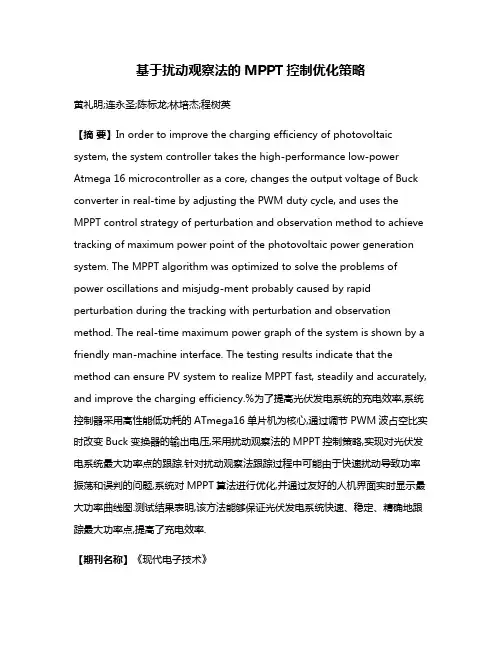
基于扰动观察法的MPPT控制优化策略黄礼明;连永圣;陈标龙;林培杰;程树英【摘要】In order to improve the charging efficiency of photovoltaic system, the system controller takes the high-performance low-power Atmega 16 microcontroller as a core, changes the output voltage of Buck converter in real-time by adjusting the PWM duty cycle, and uses the MPPT control strategy of perturbation and observation method to achieve tracking of maximum power point of the photovoltaic power generation system. The MPPT algorithm was optimized to solve the problems of power oscillations and misjudg-ment probably caused by rapid perturbation during the tracking with perturbation and observation method. The real-time maximum power graph of the system is shown by a friendly man-machine interface. The testing results indicate that the method can ensure PV system to realize MPPT fast, steadily and accurately, and improve the charging efficiency.%为了提高光伏发电系统的充电效率,系统控制器采用高性能低功耗的ATmega16单片机为核心,通过调节PWM波占空比实时改变Buck变换器的输出电压,采用扰动观察法的MPPT控制策略,实现对光伏发电系统最大功率点的跟踪.针对扰动观察法跟踪过程中可能由于快速扰动导致功率振荡和误判的问题,系统对MPPT算法进行优化,并通过友好的人机界面实时显示最大功率曲线图.测试结果表明,该方法能够保证光伏发电系统快速、稳定、精确地跟踪最大功率点,提高了充电效率.【期刊名称】《现代电子技术》【年(卷),期】2011(034)024【总页数】3页(P206-208)【关键词】光伏发电系统;MPPT;扰动观察法;算法优化【作者】黄礼明;连永圣;陈标龙;林培杰;程树英【作者单位】福州大学物理与信息工程学院,福建福州 350108;福州大学物理与信息工程学院,福建福州 350108;福州大学物理与信息工程学院,福建福州 350108;福州大学物理与信息工程学院,福建福州 350108;福州大学物理与信息工程学院,福建福州 350108【正文语种】中文【中图分类】TN911-34随着能源危机的加重和人们对清洁能源的广泛使用,光伏发电技术已越来越被人们所重视。
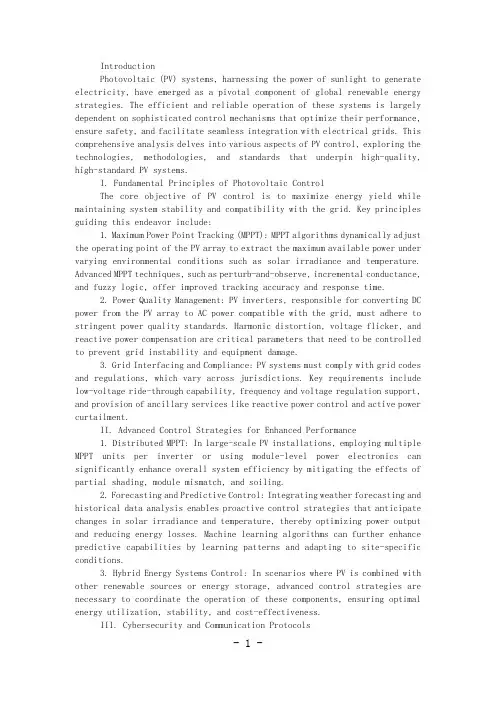
IntroductionPhotovoltaic (PV) systems, harnessing the power of sunlight to generate electricity, have emerged as a pivotal component of global renewable energy strategies. The efficient and reliable operation of these systems is largely dependent on sophisticated control mechanisms that optimize their performance, ensure safety, and facilitate seamless integration with electrical grids. This comprehensive analysis delves into various aspects of PV control, exploring the technologies, methodologies, and standards that underpin high-quality, high-standard PV systems.I. Fundamental Principles of Photovoltaic ControlThe core objective of PV control is to maximize energy yield while maintaining system stability and compatibility with the grid. Key principles guiding this endeavor include:1. Maximum Power Point Tracking (MPPT): MPPT algorithms dynamically adjust the operating point of the PV array to extract the maximum available power under varying environmental conditions such as solar irradiance and temperature. Advanced MPPT techniques, such as perturb-and-observe, incremental conductance, and fuzzy logic, offer improved tracking accuracy and response time.2. Power Quality Management: PV inverters, responsible for converting DC power from the PV array to AC power compatible with the grid, must adhere to stringent power quality standards. Harmonic distortion, voltage flicker, and reactive power compensation are critical parameters that need to be controlled to prevent grid instability and equipment damage.3. Grid Interfacing and Compliance: PV systems must comply with grid codes and regulations, which vary across jurisdictions. Key requirements include low-voltage ride-through capability, frequency and voltage regulation support, and provision of ancillary services like reactive power control and active power curtailment.II. Advanced Control Strategies for Enhanced Performance1. Distributed MPPT: In large-scale PV installations, employing multiple MPPT units per inverter or using module-level power electronics can significantly enhance overall system efficiency by mitigating the effects of partial shading, module mismatch, and soiling.2. Forecasting and Predictive Control: Integrating weather forecasting and historical data analysis enables proactive control strategies that anticipate changes in solar irradiance and temperature, thereby optimizing power output and reducing energy losses. Machine learning algorithms can further enhance predictive capabilities by learning patterns and adapting to site-specific conditions.3. Hybrid Energy Systems Control: In scenarios where PV is combined with other renewable sources or energy storage, advanced control strategies are necessary to coordinate the operation of these components, ensuring optimal energy utilization, stability, and cost-effectiveness.III. Cybersecurity and Communication ProtocolsAs PV systems increasingly rely on digital communication and remote monitoring, cybersecurity becomes a paramount concern. Ensuring secure data transmission, protecting against cyber threats, and maintaining system integrity are vital for high-quality, high-standard PV control. Key aspects include:1. Secure Communication Protocols: Implementing industry-standard communication protocols like Modbus TCP/IP, DNP3, or IEC 61850, with robust encryption and authentication mechanisms, safeguards against data breaches and unauthorized access.2. Intrusion Detection and Prevention Systems: Deploying advanced cybersecurity measures, such as firewalls, intrusion detection/prevention systems (IDS/IPS), and regular firmware updates, fortifies PV systems against potential cyberattacks.3. Cybersecurity Standards Compliance: Adhering to international standards like IEC 62443 for industrial control systems security and NIST Cybersecurity Framework ensures a systematic approach to addressing cybersecurity risks in PV systems.IV. Quality Assurance and StandardizationTo guarantee high-quality, high-standard PV control, adherence to rigorous testing, certification, and standardization processes is essential. Key aspects include:1. International Standards: Compliance with international standards like IEC 61727 for MPPT performance evaluation, IEC 61000 for electromagnetic compatibility, and UL 1741 for inverter safety and performance ensures consistency and interoperability across different PV systems and markets.2. Certification and Testing: Third-party certification by recognized bodies like TÜV Rheinland, UL, or Intertek provides independent validation of PV control systems' compliance with relevant standards, enhancing reliability and consumer confidence.3. Continuous Monitoring and Maintenance: Regular system monitoring, performance assessment, and maintenance according to guidelines like O&M Best Practices Guidelines for Photovoltaic Systems ensure sustained high performance and early detection of potential issues.V. Future Perspectives and Technological AdvancesThe ongoing evolution of PV control is driven by advancements in areas such as:1. Digital Twins and Virtual Commissioning: Digital replicas of PV systems enable virtual testing and optimization of control strategies before deployment, reducing commissioning time and costs while enhancing overall system performance.2. Edge Computing and AI: Integrating edge computing devices and artificial intelligence algorithms can enable real-time, autonomous decision-making at the component level, further improving MPPT efficiency, fault detection, and predictive maintenance.3. Grid 2.0 Integration: As power grids transition towards more decentralized, flexible, and intelligent architectures (Grid 2.0), PV control systems will need to adapt to support bi-directional power flows, enhanced grid stability services, and participation in local energy markets.ConclusionHigh-quality, high-standard photovoltaic control is a multifaceted endeavor that encompasses advanced control strategies, robust cybersecurity measures, rigorous quality assurance, and continuous adaptation to technological advancements. By diligently addressing these aspects, the global PV sector can accelerate its contribution to a sustainable, resilient, and low-carbon energy future.。
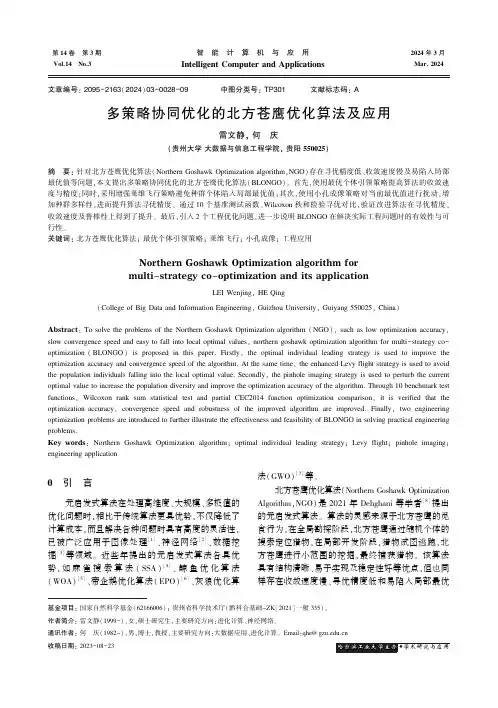
第14卷㊀第3期Vol.14No.3㊀㊀智㊀能㊀计㊀算㊀机㊀与㊀应㊀用IntelligentComputerandApplications㊀㊀2024年3月㊀Mar.2024㊀㊀㊀㊀㊀㊀文章编号:2095-2163(2024)03-0028-09中图分类号:TP301文献标志码:A多策略协同优化的北方苍鹰优化算法及应用雷文静,何㊀庆(贵州大学大数据与信息工程学院,贵阳550025)摘㊀要:针对北方苍鹰优化算法(NorthernGoshawkOptimizationalgorithm,NGO)存在寻优精度低㊁收敛速度慢及易陷入局部最优值等问题,本文提出多策略协同优化的北方苍鹰优化算法(BLONGO)㊂首先,使用最优个体引领策略提高算法的收敛速度与精度;同时,采用增强莱维飞行策略避免种群个体陷入局部最优值;其次,使用小孔成像策略对当前最优值进行扰动,增加种群多样性,进而提升算法寻优精度㊂通过10个基准测试函数㊁Wilcoxon秩和检验寻优对比,验证改进算法在寻优精度㊁收敛速度及鲁棒性上得到了提升㊂最后,引入2个工程优化问题,进一步说明BLONGO在解决实际工程问题时的有效性与可行性㊂关键词:北方苍鹰优化算法;最优个体引领策略;莱维飞行;小孔成像;工程应用NorthernGoshawkOptimizationalgorithmformulti-strategyco-optimizationanditsapplicationLEIWenjing,HEQing(CollegeofBigDataandInformationEngineering,GuizhouUniversity,Guiyang550025,China)Abstract:TosolvetheproblemsoftheNorthernGoshawkOptimizationalgorithm(NGO),suchaslowoptimizationaccuracy,slowconvergencespeedandeasytofallintolocaloptimalvalues,northerngoshawkoptimizationalgorithmformulti-strategyco-optimization(BLONGO)isproposedinthispaper.Firstly,theoptimalindividualleadingstrategyisusedtoimprovetheoptimizationaccuracyandconvergencespeedofthealgorithm.Atthesametime,theenhancedLevyflightstrategyisusedtoavoidthepopulationindividualsfallingintothelocaloptimalvalue.Secondly,thepinholeimagingstrategyisusedtoperturbthecurrentoptimalvaluetoincreasethepopulationdiversityandimprovetheoptimizationaccuracyofthealgorithm.Through10benchmarktestfunctions,WilcoxonranksumstatisticaltestandpartialCEC2014functionoptimizationcomparison,itisverifiedthattheoptimizationaccuracy,convergencespeedandrobustnessoftheimprovedalgorithmareimproved.Finally,twoengineeringoptimizationproblemsareintroducedtofurtherillustratetheeffectivenessandfeasibilityofBLONGOinsolvingpracticalengineeringproblems.Keywords:NorthernGoshawkOptimizationalgorithm;optimalindividualleadingstrategy;Levyflight;pinholeimaging;engineeringapplication基金项目:国家自然科学基金(62166006);贵州省科学技术厅(黔科合基础-ZK[2021]一般335)㊂作者简介:雷文静(1999-),女,硕士研究生,主要研究方向:进化计算㊁神经网络㊂通讯作者:何㊀庆(1982-),男,博士,教授,主要研究方向:大数据应用㊁进化计算㊂Email:qhe@gzu.edu.cn收稿日期:2023-08-230㊀引㊀言元启发式算法在处理高维度㊁大规模㊁多极值的优化问题时,相比于传统算法更具优势,不仅降低了计算成本,而且解决各种问题时具有高度的灵活性,已被广泛应用于图像处理[1]㊁神经网络[2]㊁数据挖掘[3]等领域㊂近些年提出的元启发式算法各具优势,如麻雀搜索算法(SSA)[4]㊁鲸鱼优化算法(WOA)[5]㊁帝企鹅优化算法(EPO)[6]㊁灰狼优化算法(GWO)[7]等㊂北方苍鹰优化算法(NorthernGoshawkOptimizationAlgorithm,NGO)是2021年Dehghani等学者[8]提出的元启发式算法㊂算法的灵感来源于北方苍鹰的觅食行为,在全局勘探阶段,北方苍鹰通过随机个体的搜索定位猎物,在局部开发阶段,猎物试图逃跑,北方苍鹰进行小范围的挖掘,最终捕获猎物㊂该算法具有结构清晰㊁易于实现及稳定性好等优点,但也同样存在收敛速度慢㊁寻优精度低和易陷入局部最优值等其他元启发式算法普遍拥有的问题㊂学者们针对元启发式算法存在的不足,提出不同的改进方法㊂如:Ouyang等学者[9]提出了一种改进的麻雀搜索算法,使用改进的Tent混沌映射对种群进行初始化,增加种群多样性,同时采用柯西突变法更新最优个体位置,提高算法寻优能力㊂Qiao等学者[10]引入自适应搜索包络机制和螺旋位置,有效平衡鲸鱼优化算法的全局开发和局部探索㊂Xing[11]使用Levy飞行和反向学习的方法,提高帝企鹅优化算法探索㊁开发能力㊂滕志军等学者[12]将粒子群算法的思想引入到灰狼优化算法中,保留灰狼个体最佳位置信息㊂尽管上述文献中的改进方法在一定程度上提升了算法的寻优精度和速度,但仍存在易陷入局部最优值㊁探索能力不足的情况㊂因此,为了加强NGO的寻优性能和实用性,本文提出了多策略协同优化的北方苍鹰优化算法(BLONGO)㊂1㊀北方苍鹰优化算法北方苍鹰优化算法(NGO)的灵感来源于北方苍鹰的猎捕行为,该行为主要包含2个阶段㊂第一个阶段㊁勘探阶段,即北方苍鹰进行猎物识别并发起攻击的阶段;第二个阶段㊁开发阶段,即北方苍鹰追逐及猎物尝试逃跑的阶段㊂北方苍鹰种群个体可建模如下:xi=LBi+r1ˑ(UBi-LBi),i=1,2, ,n-1,n(1)㊀㊀其中,xi是第i个北方苍鹰的位置,表示n个种群里的候选解;UBi㊁LBi分别是搜索域的上㊁下边界;r1是(0,1)之间的随机数㊂在第一阶段,种群在搜索空间中随机选择一个个体并发起攻击,其数学模型如下:xnew,p1ij=xij+r2(pij-I∗xij),㊀Fpi<Fixij+r3(I∗xij-pij),㊀FpiȡFi{(2)㊀pi=Xk,㊀k=1,2, ,i-1,i+1, ,n(3)其中,xij为当前迭代时种群的位置;Fi为其适应度值;xnew,p1ij为迭代更新后种群的新位置;pij为与当前个体不同的随机个体;Fpi为其适应度值;r2和r3是(0,1)之间的随机数;I为1或2的随机整数㊂种群位置更新后,根据更新前㊁后的适应度值确定是否采用更新后的种群位置,表达式如下:Xi=Xnew,p1i,㊀Fnew,p1i<FiXi,㊀㊀Fnew,p1iȡFi{(4)㊀㊀在第二阶段,北方苍鹰以较快的速度持续追捕猎物,并将其捕获㊂假设该狩猎行为接近一个半径为R的攻击方式,则该阶段的数学表达式如下:xnew,p2ij=xij+R(2∗r4-1)xij(5)R=0.02∗(1-tT)(6)㊀㊀其中,xij为当前迭代时种群的位置;xnew,p2ij为迭代更新后种群的新位置;r4是(0,1)之间的随机数;t为当前迭代次数;T为最大迭代次数㊂与第一阶段相似,确定是否更新种群位置的表达式如下:Xi=Xnew,p2i,㊀Fnew,p2i<FiXi,㊀㊀Fnew,p2iȡFi{(7)2㊀多策略协同优化的北方苍鹰优化算法2.1㊀最优个体引领策略第一阶段中,种群选择与当前个体不同的随机个体进行攻击㊂这种位置更新方式有利于算法在迭代前期对未知个体的探索,但在迭代后期,种群接近收敛,随机个体的盲目性导致算法收敛速度慢㊁寻优精度不高㊂针对上述问题,本文采用最优个体引领策略,在算法迭代的前期(迭代次数小于总迭代次数的一半),仍采用式(2)的随机个体引领更新方式,在算法迭代的后期,采用最优个体的引领更新方式,其数学表达式如下:㊀xnew,p1ij=xij+r1(xbest-I∗xij),㊀Fxbest<Fixij+r2(I∗xij-xbest),㊀FxbestȡFi{(8)㊀㊀其中,xbest为种群的当前最优个体,Fxbest为其适应度值㊂在第一阶段的寻优过程中,对种群的位置更新进行分段处理,不仅可以保持算法在迭代前期对未知个体的探索,而且在迭代后期使用最优个体的引领,可提高算法的寻优精度和收敛速度㊂2.2㊀增强莱维飞行策略在NGO的寻优过程中,不论在第一阶段㊁还是第二阶段,当前个体都起到了关键性作用㊂经过第一阶段的位置更新,在第二阶段时,当前个体陷入局部最优值的可能性更大,因此在第二阶段引入增强莱维飞行策略,促使当前个体顺利跳出局部最优值㊂更新后的位置更新公式如下:xnew,p2ij=xij∗α(t)∗0.05∗μ∗σν1β+R(2∗r2-1)xij(9)92第3期雷文静,等:多策略协同优化的北方苍鹰优化算法及应用σ=Γ(1+β)∗sin(πβ/2)Γ(1+β2)∗β∗(2β-12)æèççöø÷÷(1/β)(10)α(t)=(1-tT)(tT)æèçöø÷2(11)㊀㊀其中,μ和σ是(0,1)之间的随机数;β是默认常数,取值为1.5;α(t)是随迭代次数动态变化的系数因子;t为当前迭代次数;T为最大迭代次数㊂本文在基本的莱维飞行上做了强化,引入α(t),其值随迭代次数的增加非线性递减,在一定程度上减小了莱维飞行的不确定性㊂具体分析如下:在迭代前期,若莱维飞行随机数取值较小,较大的α值保留了当前个体以较大的步长逃离局部最优的可能性;在迭代后期,种群个体接近收敛,若莱维飞行随机数取值较大,不利于算法求得高精度的解,较小的α值保留了当前个体以较小的步长逃离局部最优的可能性㊂2.3㊀小孔成像策略在算法迭代的后期,种群的多样性减少,种群将会集中出现在当前最优个体附近㊂在此前的2种改进策略中,虽然改变了种群的引领方式㊁促使种群逃离局部最优值,却未对种群位置进行扰动㊂所以,本文提出小孔成像的策略,并将其逐维运用到当前最优值上,不仅避免种群个体之间相互干扰,还能对当前最优解进行位置扰动,增加当前最优解的多样性㊂其一维数学模型如下:(a+b)/2-xx∗-(a+b)/2=ppᶄ(12)㊀㊀若将其拓展到多维空间,并应用于当前最优值,则表达式变为:(aji+bji)/2-xjbestxjbest∗-(aji+bji)/2=ppᶄ(13)㊀㊀设缩放因子p/pᶄ=k,通过变换可以得到基于小孔成像的解为:xjbest∗=(aji+bji)2+(aji+bji)2ˑk-xjbestk(14)㊀㊀其中,aji㊁bji分别表示第i个种群第j维的上㊁下边界,xjbest表示当前最优值第j维对应的数值㊂本文设置缩放因子k的取值范围为[-1.5,1.5],以一维平面为例,小孔成像的解将不仅可以存在于小孔屏幕的右侧,还可以存在于左侧,增加了当前最优值的多样性,从而提升算法寻优精度㊂虽然对当前最优值使用小孔成像的方法进行扰动,在下一次迭代中,有助于种群逃离局部最优值,但没法保证扰动后的当前最优解一定优于扰动前的解㊂因此,对比扰动前㊁后种群位置的适应度值,保留对位置更新更具价值的当前最优解㊂其数学模型如下:xbest=xbest,㊀f(xbest)<f(xbest∗)xbest∗,㊀f(xbest)ȡf(xbest∗){(15)3㊀实验仿真与结果分析3.1㊀仿真环境与测试函数仿真实验均在Intel(R)Core(TM)i5-6500CPU㊁3.20GHz主频㊁Windows10(64位)操作系统上完成,编程软件为MatlabR2016a㊂表1列出了实验所需的10个基准测试函数㊂其中,F1 F5为单峰函数,F6 F8为复杂多峰函数,F9 F10为固定维度的多峰函数㊂表1㊀基准测试函数Table㊀1㊀Benchmarkfunctions编号名称维度定义域理论值F1Sphere30/200/500[-100,100]0F2Schwefel.2.2230/200/500[-10,10]0F3Schwefel.1.230/200/500[-100,100]0F4Schwefel.2.2130/200/500[-100,100]0F5Quartic30/200/500[-1.28,1.28]0F6Rastrigin30/200/500[-5.12,5.12]0F7Ackley30/200/500[-32,32]0F8Griewank30/200/500[-600,600]0F9Kowalik's4[-5,5]0.0003F10Goldstein2[-2,2]33.2㊀不同改进策略数值寻优对比为了验证各改进策略的有效性,将标准的北方苍鹰优化算法(NGO)㊁引入最优个体引领策略的北方苍鹰优化算法(BNGO)㊁引入增强莱维飞行策略的北方苍鹰优化算法(LNGO)㊁引入小孔成像策略的北方苍鹰优化算法(ONGO)与多策略协同优化的北方苍鹰优化算法(BLONGO),在表1中的基准函数上进行数值寻优对比㊂为了保证实验结果的公平性并减少误差,各算法独立运行30次,总迭代次数为500次,种群规模30,算法维度30㊂将独立运行得到的结果取最优值㊁最差值㊁平均值和标准差,实验结果见表2㊂03智㊀能㊀计㊀算㊀机㊀与㊀应㊀用㊀㊀㊀㊀㊀㊀㊀㊀㊀㊀㊀㊀㊀㊀第14卷㊀表2㊀不同改进策略的数值寻优对比Table2㊀Comparisonofnumericaloptimizationofdifferentimprovementstrategies函数算法最优值最差值平均值标准差F1NGO1.11E-891.01E-856.54E-872.23E-86BNGO7.77E-2174.82E-2085.01E-2090.00E+00LNGO0.00E+000.00E+000.00E+000.00E+00ONGO0.00E+000.00E+000.00E+000.00E+00BLONGO0.00E+000.00E+000.00E+000.00E+00F2NGO1.04E-463.62E-459.96E-469.82E-46BNGO2.91E-1136.59E-1098.91E-1101.88E-109LNGO0.00E+000.00E+000.00E+000.00E+00ONGO0.00E+000.00E+000.00E+000.00E+00BLONGO0.00E+000.00E+000.00E+000.00E+00F3NGO3.99E-294.92E-225.00E-231.30E-22BNGO1.47E-1502.91E-1281.73E-1296.56E-129LNGO0.00E+000.00E+000.00E+000.00E+00ONGO0.00E+000.00E+000.00E+000.00E+00BLONGO0.00E+000.00E+000.00E+000.00E+00F4NGO1.55E-381.84E-362.46E-373.96E-37BNGO3.34E-981.68E-919.88E-933.75E-92LNGO0.00E+000.00E+000.00E+000.00E+00ONGO0.00E+000.00E+000.00E+000.00E+00BLONGO0.00E+000.00E+000.00E+000.00E+00F5NGO1.03E-041.11E-035.66E-042.63E-04BNGO7.49E-056.20E-042.93E-041.66E-04LNGO1.74E-068.88E-056.34E-053.46E-05ONGO1.74E-062.48E-043.17E-055.39E-05BLONGO1.63E-068.23E-053.11E-052.46E-05F6NGO0.00E+000.00E+000.00E+000.00E+00BNGO0.00E+000.00E+000.00E+000.00E+00LNGO0.00E+000.00E+000.00E+000.00E+00ONGO0.00E+000.00E+000.00E+000.00E+00BLONGO0.00E+000.00E+000.00E+000.00E+00F7NGO4.44E-157.99E-156.57E-151.99E-15BNGO4.44E-157.99E-156.11E-151.78E-15LNGO8.88E-168.88E-168.88E-161.89E-15ONGO8.88E-168.88E-168.88E-160.00E+00BLONGO8.88E-168.88E-168.88E-160.00E+00F8NGO0.00E+000.00E+000.00E+000.00E+00BNGO0.00E+000.00E+000.00E+000.00E+00LNGO0.00E+000.00E+000.00E+000.00E+00ONGO0.00E+000.00E+000.00E+000.00E+00BLONGO0.00E+000.00E+000.00E+000.00E+00F9NGO3.07E-043.21E-043.08E-042.88E-06BNGO3.07E-043.08E-043.08E-043.04E-08LNGO3.07E-043.07E-043.07E-045.06E-10ONGO3.07E-043.07E-043.07E-043.26E-10BLONGO3.07E-043.07E-043.07E-041.42E-10F10NGO3.00E+003.00E+003.00E+002.17E-15BNGO3.00E+003.00E+003.00E+001.88E-15LNGO3.00E+003.00E+003.00E+001.45E-15ONGO3.00E+003.00E+003.00E+009.28E-16BLONGO3.00E+003.00E+003.00E+001.87E-16㊀㊀由表2数据可知,本次数值实验的结果展现了算法的寻优精度及寻优稳定性㊂对于函数F1 F4和F6,BLONGO㊁LNGO和ONGO在最优值㊁最差值和平均值上均寻到了理论最优值,且寻优标准差为0,说明增强莱维飞行策略能协助种群逃离局部最优值;小孔成像策略对当前最优值进行扰动,能够增加当前最优解的多样性,提升算法寻优精度㊂虽然BNGO未能寻到最优值,但其求解精度较NGO有较大提升,且寻优性能稳定㊂对于函数F5㊁F7和F9,BLONGO虽未寻到理论最优值,但在各改进算法中,BLONGO的寻优精度和稳定性都位列第一,说明协同三种改进策略的BLONGO具有更好的寻优性能;对于函数F8,各算法在数值上的寻优性能一致㊂对于函数F10,各算法都求得理论最优值,但BLONGO的寻优过程更加稳定㊂13第3期雷文静,等:多策略协同优化的北方苍鹰优化算法及应用综上分析,对10个基准测试函数进行数值寻优时,LNGO和ONGO的寻优精度和寻优稳定性有大幅提升,BNGO的寻优能力次之,但寻优精度和稳定性优于基本NGO㊂虽然不同改进策略都是有效的,但融合3种改进策略的BLONGO效果最好㊂为了进一步验证寻优效果,将对不同改进策略采用收敛曲线进行对比分析㊂3.3㊀不同改进策略平均收敛曲线对比收敛曲线能够更直观地展现算法的寻优速度与精度,现将NGO㊁BNGO㊁LNGO㊁ONGO与BLONGO在表1中的基准函数及设定参数下运行,其平均收敛曲线如图1所示㊂(j )F 10平均收敛曲线50100150200250300350400450500100100010001000N G OB N G O L N G O O N G O B L O N G O最佳适应度值(a )F 1平均收敛曲线迭代次数5010015020025030035040045050010100010001000N G OB N G O L N G O O N G O B L O N G O最佳适应度值(b )F 2平均收敛曲线迭代次数5010015020025030035040045050010100010001000N G OB N G O L N G O O N G O B L O N G O最佳适应度值(c )F 3平均收敛曲线迭代次数5010015020025030035040045050010100010001000N G OB N G O L N G O O N G O B L O N G O最佳适应度值(d )F 4平均收敛曲线迭代次数(e )F 5平均收敛曲线(f )F 6平均收敛曲线(g )F 7平均收敛曲线(h )F 8平均收敛曲线(i )F 9平均收敛曲线5010015020025030035040045050010100101010N G OB N G O L N G O O N G O B L O N G O最佳适应度值迭代次数20406080100101010N G OB N G O L N G O O N G O B L O N G O最佳适应度值迭代次数5010015020025030035040045050010101010N G OB N G O L N G O O N G O B L O N G O最佳适应度值迭代次数20406080100120迭代次数N G OB N G O L N G O O N G O B L O N G O10101010最佳适应度值50100150200250300350400450500101010N G OB N G O L N G O O N G O B L O N G O最佳适应度值迭代次数1010最佳适应度值N G OB N G O L N G O O N G O B L O N G O100200300400500迭代次数0图1㊀不同改进策略的平均收敛曲线Fig.1㊀Averageconvergencecurvesofdifferentimprovementstrategies㊀㊀从图1可知,对于函数F1 F4㊁F6和F8,BLONGO的收敛曲线一直位于对比算法的下方,说明其不论在前期的收敛速度㊁还是在后期的寻优精度上,都具有优越性;对于函数F5,BLONGO相比于其他的改进算法能更好地逃离局部最优值,不断向最优值寻优;对于函数F7,虽然BNGO与NGO在最终的求解精度上相差不大,但BNGO的寻优速度更快,BLONGO㊁LNGO和ONGO的收敛速度和寻优精度较NGO均有大幅提升;对于函数F9和F10,各算法在寻优精度上差别不大,但添加了改进策略后的算法在收敛速度上更占优势,其中BLONGO的收敛速度最快㊂综合表2的数值寻优结果和图1的平均收敛曲线可以看出:改进后的算法较原始算法具有更好的寻优精度和稳定性㊂在所有改进算法中,BLONGO能不断逃离局部最优值,且具有最高的寻优精度和最快的收敛速度㊂3.4㊀与其他改进算法分维度对比将BLONGO与改进的阿基米德优化算法(SAOA)[13]㊁改进的鲸鱼优化算法(IWOA[14]㊁CWOA[15])㊁改进的被囊群算法(LFATSA)[16]和改进的蝴蝶优化算法(PWMBOA)[17-18]在表1的基准测试函数上进行寻优对比㊂除了维度固定的多峰函数F9㊁F10空间维度分别设置为4㊁2,其余函数的空间维度分别设置为30/200/500㊂引用文献[13]㊁[14]和[15]的数据,并复现文献[16]㊁[17]的实验㊂各算法独立运行30次,总迭代次数500次,种群规模30,将各算法独立运行的结果取平均值与标准差,并记录在表3与表4中,表中的 表示原文献中没有对应值㊂23智㊀能㊀计㊀算㊀机㊀与㊀应㊀用㊀㊀㊀㊀㊀㊀㊀㊀㊀㊀㊀㊀㊀㊀第14卷㊀表3㊀不同维度下各算法对单峰函数与多峰函数的求解结果比较Table3㊀Comparisonofthesolutionresultsofunimodalfunctionsandmultimodalfunctionsbyvariousalgorithmsindifferentdimensions函数算法30dim平均值标准差200dim平均值标准差500dim平均值标准差F1SAOA[13]0.00E+000.00E+000.00E+000.00E+000.00E+000.00E+00IWOA[14]6.54E-1256.80E-1252.62E-1161.50E-1164.85E-1133.28E-113CWOA[15]0.00E+000.00E+000.00E+000.00E+000.00E+000.00E+00LFATSA0.00E+000.00E+000.00E+000.00E+000.00E+000.00E+00PWMBOA5.07E-2810.00E+002.16E-2780.00E+003.74E-2720.00E+00BLONGO0.00E+000.00E+000.00E+000.00E+000.00E+000.00E+00F2SAOA[13]2.56E-3070.00E+008.00E-3190.00E+003.90E-3140.00E+00IWOA[14]2.15E-733.64E-731.68E-671.95E-675.32E-669.60E-66CWOA[15]4.56E-2260.00E+009.53E-2430.00E+001.24E-2300.00E+00LFATSA6.45E-2022.88E+002.63E-2020.00E+008.94E-2020.00E+00PWMBOA0.00E+000.00E+000.00E+000.00E+000.00E+000.00E+00BLONGO0.00E+000.00E+000.00E+000.00E+000.00E+000.00E+00F3SAOA[13]0.00E+000.00E+000.00E+000.00E+000.00E+000.00E+00IWOA[14]1.56E-231.81E-23CWOA[15]LFATSA0.00E+000.00E+000.00E+000.00E+000.00E+000.00E+00PWMBOA1.96E-2790.00E+002.12E-2790.00E+003.72E-2790.00E+00BLONGO0.00E+000.00E+000.00E+000.00E+000.00E+000.00E+00F4SAOA[13]3.51E-2990.00E+005.26E-2970.00E+001.27E-3120.00E+00IWOA[14]7.06E-072.18E-06CWOA[15]3.60E-2650.00E+002.49E-2140.00E+001.90E-2190.00E+00LFATSA0.00E+000.00E+002.45E-2010.00E+002.67E-2030.00E+00PWMBOA0.00E+000.00E+000.00E+000.00E+000.00E+000.00E+00BLONGO0.00E+000.00E+000.00E+000.00E+000.00E+000.00E+00F5SAOA[13]4.75E-054.37E-056.11E-057.32E-057.66E-058.17E-05IWOA[14]2.42E-044.41E-041.44E-031.77E-032.04E-032.47E-03CWOA[15]3.61e-053.73e-053.50e-053.21e-054.12e-053.56e-05LFATSA4.42E-054.48E-054.55E-057.61E-055.38E-055.74E-05PWMBOA5.20E-056.31E-055.00E-058.54E-055.46E-058.79E-05BLONGO3.11E-052.46E-053.32E-052.66E-053.88E-053.28E-05F6SAOA[13]0.00E+000.00E+000.00E+000.00E+000.00E+000.00E+00IWOA[14]0.00E+000.00E+000.00E+000.00E+000.00E+000.00E+00CWOA[15]0.00E+000.00E+000.00E+000.00E+000.00E+000.00E+00LFATSA0.00E+000.00E+000.00E+000.00E+000.00E+000.00E+00PWMBOA0.00E+000.00E+000.00E+000.00E+000.00E+000.00E+00BLONGO0.00E+000.00E+000.00E+000.00E+000.00E+000.00E+00F7SAOA[13]8.88E-160.00E+008.88E-160.00E+008.88E-160.00E+00IWOA[14]3.02E-151.95E-158.88E-160.00E+004.44E-150.00E+00CWOA[15]8.88E-164.01E-318.88E-164.01E-318.88E-164.01E-31LFATSA1.48E-163.37E-162.96E-164.26E-162.96E-164.26E-16PWMBOA1.48E-163.37E-162.96E-164.26E-162.96E-164.26E-16BLONGO1.48E-163.37E-162.96E-164.26E-162.96E-164.26E-16F8SAOA[13]0.00E+000.00E+000.00E+000.00E+000.00E+000.00E+00IWOA[14]0.00E+000.00E+000.00E+000.00E+000.00E+000.00E+00CWOA[15]0.00E+000.00E+000.00E+000.00E+000.00E+000.00E+00LFATSA0.00E+000.00E+000.00E+000.00E+000.00E+000.00E+00PWMBOA0.00E+000.00E+000.00E+000.00E+000.00E+000.00E+00BLONGO0.00E+000.00E+000.00E+000.00E+000.00E+000.00E+00㊀㊀由表3的寻优结果可知:从纵向来看,对于函数F1 F4,BLONGO在不同维度上均寻到理论最优值,而对比算法中,除了IWOA都未寻到理论最优值之外,其他算法仅在部分函数上找到理论最优值;对于函数F5,BLONGO虽未寻到理论最优值,但其求解精度和稳定性是对比算法里最好的,寻优效果显著;对于函数F6和F8,BLONGO与对比算法均能寻到理论值;对于函数F7,BLONGO与LFATSA㊁PWMBOA的寻优精度相同,高于其他对比算法㊂从横向来看,各算法的求解精度随着维度的增加均有递减的趋势,这是因为种群维度的增加伴随着空间范围的扩大及计算量的提高所致㊂BLONGO对维度增加的敏感性较弱,在函数F1 F4㊁F6 F8上其求解精度没有随着维度的增加而发生变化,而对比的5种算法对部分函数的求解精度有所下降;对于函数F5,BLONGO和对比算法的求解精度和稳定性都有所下降,但BLONGO的平均值与标准差仍是对比算法里表现最好的㊂33第3期雷文静,等:多策略协同优化的北方苍鹰优化算法及应用综上所述,无论是求解低维㊁还是高维问题,BLONGO在求解精度及稳定性上均存在竞争性㊂㊀㊀从表4可知,对于2个固定维度的多峰函数,除了SAOA㊁IWOA和CWOA的实验数据在文献中未给出,其余的3种算法中BLONGO的平均值最接近理论最优值,且具有最小的标准差,说明BLONGO在求解维度固定的多峰函数时,具有一定的优越性㊂表4㊀不同算法对固定维度多峰函数的求解结果比较Table4㊀Comparisonofsolutionresultsofdifferentalgorithmsforfixed-dimensionalmultimodalfunctions函数维度算法平均值标准差F92dimSAOA[19]--IWOA[20]--CWOA[21]--LFATSA3.63E-036.73E-03PWMBOA4.76E-034.56E-03BLONGO3.07E-041.42E-10F104dimSAOA[19]--IWOA[20]--CWOA[21]--LFATSA3.65E+002.53E-10PWMBOA3.96E+006.51E-14BLONGO3.00E+001.87E-163.5㊀Wilcoxon秩和检验在之前的数值实验中,仅对比分析了各改进策略的最优值㊁最差值㊁平均值和标准差,却未从统计学上验证BLONGO的鲁棒性和可靠性㊂为了进一步验证BLONGO的有效性,这里将BLONGO与标准的北方苍鹰优化算法(NGO)㊁粒子群算法(PSO)[18]㊁蝴蝶优化算法(BOA)[19]㊁BNGO㊁LNGO㊁ONGO在p=0.05的显著性水平下进行Wilcoxon秩和检验㊂为了保证实验的公平性,各算法独立运行30次,最大迭代次数500次,种群规模30,算法维度30㊂当p小于0.05时,拒绝原假设,说明2个对比算法在统计学上存在明显差异,反之接受原假设,说明2个对比算法之间差异不明显㊂表5中,NaN表示不适用, + ㊁ - 和 = 分别代表BLONGO优于㊁劣于和相似于对比算法㊂Wilcoxon秩和检验结果见表5㊂从表5的总体来看,表5内大部分p值都小于0.05,从统计学的角度看,BLONGO与对比算法的寻优存在明显差异,进一步验证了BLONGO的鲁棒性和可靠性㊂表5㊀Wilcoxon秩和检验结果Table5㊀Wilcoxonranksumtestresults函数NGOp1PSOp2BOAp3BNGOp4LNGOp5ONGOp6F11.21E-121.21E-121.21E-121.21E-121.21E-12NaNF21.21E-121.21E-121.21E-121.21E-121.21E-121.21E-12F31.21E-121.21E-121.21E-121.21E-121.21E-12NaNF41.21E-121.21E-121.21E-121.21E-121.21E-121.21E-12F51.07E-093.02E-113.02E-111.17E-091.39E-063.42E-03F6NaN1.21E-121.94E-09NaNNaNNaNF76.25E-101.21E-121.21E-12NaN1.61E-061.55E-03F8NaN1.21E-121.21E-12NaNNaNNaNF107.46E-022.71E-023.58E-016.20E-018.59E-016.05E-01F114.49E-035.12E-031.07E-026.62E-032.75E-025.12E-02+/=/-7/2/110/0/09/0/16/3/17/2/14/4/24㊀BLONGO工程应用及结果分析工程约束问题的解决方法主要分为传统方法和元启发式算法两类㊂其中,传统方法由于结构复杂,在实现上具有一定的困难;元启发算法虽然结构简单,但在实际工程应用中难以得到较好的精度㊂因此,将本文改进算法使用到工程应用优化问题中,验证其有效性和可行性㊂下面,以压力容器和拉力弹簧设计为例,进行工程约束问题的分析㊂4.1㊀压力容器设计问题压力容器设计问题的提出,是为了尽量减少圆柱形容器的材料㊁成型和焊接的总成本,其结构示意如图2所示㊂图2中4个设计变量分别是壳体厚度Ts㊁封头厚度Th㊁壳体半径R以及圆柱形截面长度L㊂本文将正弦余弦算法(SCA)[20]㊁蚁狮算法(ALO)[21]㊁鲸43智㊀能㊀计㊀算㊀机㊀与㊀应㊀用㊀㊀㊀㊀㊀㊀㊀㊀㊀㊀㊀㊀㊀㊀第14卷㊀鱼优化算法(WOA)㊁协同进化差分进化算法(CDE)[22]和协同进化粒子群优化算法(CPSO)[23]作为对比算法,分别对该问题进行求解㊂为了保证实验的公平性,各算法独立运行30次,总迭代次数1000次,种群规模30,对各算法的实验结果取平均值,最终的计算结果见表6㊂表6㊀求解压力容器设计问题的最优解对比Table6㊀Comparisonofoptimalsolutionsforpressurevesseldesignproblem算法z1z2z3z4f(z)SCA2.56081.9895100.0394196.06626304.9418ALO0.81760.404142.3615173.40355956.1685WOA0.91620.489047.4699119.77706310.4034CDE0.81250.437542.0984176.63766059.7340CPSO0.81250.437542.0913176.74656061.0777NGO0.77850.390440.3285199.87975903.1650BLONGO0.77820.384740.3214199.97495885.3908T hT SRLR图2㊀压力容器结构设计图Fig.2㊀Structuredesignofpressurevessel㊀㊀压力容器的数学模型如下:minf(z)=0.6624z1z3z4+1.778z2z23+3.1661z21z4+19.84z21z3(16)其中,z1㊁z2㊁z3和z4分别表示TS㊁Th㊁R以及L对应的变量值,约束条件为:g1(z)=-z1+0.0193z2ɤ0g2(z)=-z2+0.00954z3ɤ0g3(z)=-πz23z4-4πz333+129000ɤ0g4(z)=-z4+240ɤ0ìîíïïïïïï(17)s.t.0ɤz1,z2ɤ100;10ɤz3,z4ɤ2004.2㊀拉力弹簧设计问题拉力弹簧设计问题的目的是最小化张力弹簧的质量,结构设计如图3所示㊂该问题包含3个决策变量,分别为:线圈直径d㊁平均线圈直径D和绕线圈数P㊂实验所需对比算法及参数设置与4.1节保持一致,实验结果见表7㊂㊀㊀拉力弹簧的数学模型如下:minf(z)=z21z22+z3()(18)㊀㊀其中,z1㊁z2和z3分别表示d㊁D和P对应的变量值,约束条件为:g1(x)=1-x32x371785x41ɤ0g2(x)=4x22-x1x212566x2x31-x41()+15108x21-1ɤ0g3(x)=1-140.45x1x22x3ɤ0g4(x)=x1+x21.5-1ɤ0ìîíïïïïïïïïïïïï(19)0.05ɤx1ɤ2,0.25ɤx2ɤ1.3,2ɤx3ɤ15P dPD图3㊀拉压弹簧结构示意图Fig.3㊀Tensionandcompressionspringstructurediagram表7㊀求解拉压弹簧设计问题的最优解对比Table7㊀Comparisonofoptimalsolutionstosolvetensionandcompressionspringdesignproblem算法z1z2z3f(z)SCA0.05480.276613.45120.012747ALO0.05000.317414.02780.012719WOA0.06400.73003.08780.015193CDE0.05160.354711.41080.012670CPSO0.05170.357611.24450.012674NGO0.05310.39149.51770.012706BLONGO0.05130.347711.98170.012643㊀㊀由表6㊁表7可知,相较于其他算法,BLONGO能成功计算压力容器设计问题的最小成本和拉力弹簧设计问题的最小质量,验证了BLONGO在求解实53第3期雷文静,等:多策略协同优化的北方苍鹰优化算法及应用际工程应用问题时的有效性与应用性㊂5 结束语为了改善NGO存在的缺陷,本文提出了多策略协同优化的北方苍鹰优化算法:在算法迭代的后半段采用最优个体引领种群位置更新,提升算法的收敛精度与速度;对标准的莱维飞行机制进行加强,使得算法在整个寻优过程中能够以更合理的步长逃离局部极值;通过引入小孔成像,对当前最优个体进行扰动,增加种群个体的多样性,并保留更具价值的当前最优个体带领种群向全局最优值靠拢,提高算法的寻优精度㊂为了验证改进算法的优越性和鲁棒性,将BLONGO与其他算法在10个基准测试函数㊁Wilcoxon秩和检验上进行寻优对比㊂此外,通过2个工程实例问题的求解,验证了BLONGO在实际工程领域应用的可行性与实用性㊂参考文献[1]MOHAMEDAW,SABRYHZ.Constrainedoptimizationbasedonmodifieddifferentialevolutionalgorithm[J].InformationScience,2012(194):171-208.[2]ARHOREEG,YASAEEM,DAYYANII.Optimisationofconvolutionalneuralnetworkarchitectureusinggeneticalgorithmforthepredictionofadhesivelybondedjointstrength[J].StructuralandMultidisciplinaryOptimization,2022,65(9):256.[3]YACOUBIS,MANITAG,AMDOUNIH,etal.Amodifiedmulti-objectiveslimemouldalgorithmwithorthogonallearningfornumericalassociationrulesmining[J].NeuralComputingandApplications,2023,35(8):6125-6151.[4]XUEJiankai,SHENBo.Anovelswarmintelligenceoptimizationapproach:sparrowsearchalgorithm[J].SystemsScience&ControlEngineering,2020,8(1):22-34.[5]MIEJALILIS,LEWISA.Thewhaleoptimizationalgorithm[J].AdvancesinEngineeringSoftware,2016,95:51-67.[6]DHIMANG,KUMARV.Emperorpenguinoptimizer:Abio-inspiredalgorithmforengineeringproblems[J].Knowledge-BasedSystems,2018,159:20-50.[7]MIRJALILIS,MIRJALILISM,LEWISA.Greywolfoptimizer[J].AdvancesinEngineeringSoftware,2014,69:46-61.[8]DEHGHANIM,HUB LOVSKY'Š,TROJOVSKY'P.Northerngoshawkoptimization:Anewswarm-basedalgorithmforsolvingoptimizationproblems[J].IEEEAccess,2021,9:162059-162080.[9]OUYANGChengtian,LIUYujia,ZHUDonglin.Anadaptivechaoticsparrowsearchoptimizationalgorithm[C]//2021IEEE2ndInternationalConferenceonBigData,ArtificialIntelligenceandInternetofThingsEngineering(ICBAIE).Nanchang,China:IEEE,2021:76-82.[10]QIAOWeibiao,YANGZhe,KANGZhangyang,etal.Short-termnaturalgasconsumptionpredictionbasedonVolterraadaptivefilterandimprovedwhaleoptimizationalgorithm[J].EngineeringApplicationsofArtificialIntelligence,2020,87:103323.[11]XINGZ.Animprovedemperorpenguinoptimizationbasedmultilevelthresholdingforcolorimagesegmentation[J].Knowledge-BasedSystems,2020,194:105570.[12]滕志军,吕金玲,郭力文,等.一种基于Tent映射的混合灰狼优化的改进算法[J].哈尔滨工业大学学报,2018,50(11):40-49.[13]罗仕杭,何庆.融合Sin混沌和分段权值的阿基米德优化算法[J].计算机工程与应用,2022,58(14):63-72.[14]龙文,蔡绍洪,焦建军,等.求解大规模优化问题的改进鲸鱼优化算法[J].系统工程理论与实践,2017,37(11):2983-2994.[15]王坚浩,张亮,史超,等.基于混沌搜索策略的鲸鱼优化算法[J].控制与决策,2019,34(9):1893-1900.[16]梁建明,何庆.莱维飞行和反馈策略的自适应被囊群算法[J].小型微型计算机系统,2023,44(1):68-74.[17]李守玉,何庆,杜逆索.分段权重和变异反向学习的蝴蝶优化算法[J].计算机工程与应用,2021,57(22):92-101.[18]POLIR,KENNEDYJ,BLACKWELLT.Particleswarmoptimization[J].SwarmIntelligence,2007,1(1):33-57.[19]ARORAS,SINGHS.Butterflyoptimizationalgorithm:Anovelapproachforglobaloptimization[J].SoftComputing,2019,23(3):715-734.[20]MIRJALILIS.SCA:Asinecosinealgorithmforsolvingoptimizationproblems[J].Knowledge-basedSystems,2016,96:120-133.[21]MIRJALILIS.Theantlionoptimizer[J].AdvancesinEngineeringSoftware,2015,83:80-98.[22]HUANGF,WANGL,HEQ.Aneffectiveco-evolutionarydifferentialevolutionforconstrainedoptimization[J].AppliedMathematicsandComputation,2007,186(1):340-356.[23]HEQie,WANGLing.Aneffectiveco-evolutionaryparticleswarmoptimizationforconstrainedengineeringdesignproblems[J].EngineeringApplicationsofArtificialIntelligence,2007,20(1):89-99.63智㊀能㊀计㊀算㊀机㊀与㊀应㊀用㊀㊀㊀㊀㊀㊀㊀㊀㊀㊀㊀㊀㊀㊀第14卷㊀。
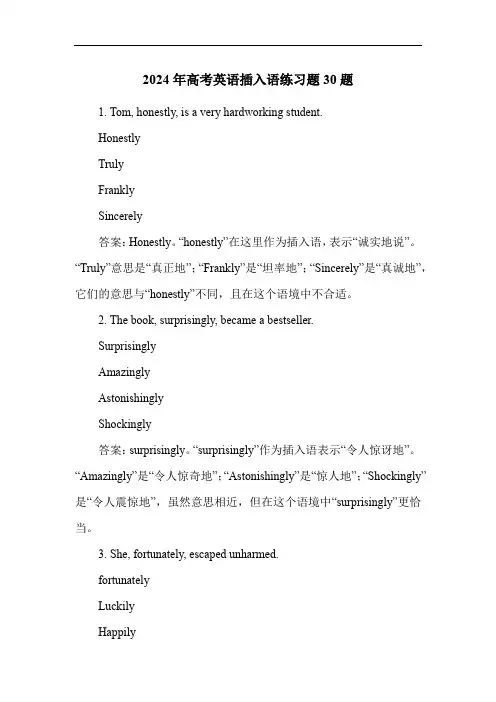
2024年高考英语插入语练习题30题1. Tom, honestly, is a very hardworking student.HonestlyTrulyFranklySincerely答案:Honestly。
“honestly”在这里作为插入语,表示“诚实地说”。
“Truly”意思是“真正地”;“Frankly”是“坦率地”;“Sincerely”是“真诚地”,它们的意思与“honestly”不同,且在这个语境中不合适。
2. The book, surprisingly, became a bestseller.SurprisinglyAmazinglyAstonishinglyShockingly答案:surprisingly。
“surprisingly”作为插入语表示“令人惊讶地”。
“Amazingly”是“令人惊奇地”;“Astonishingly”是“惊人地”;“Shockingly”是“令人震惊地”,虽然意思相近,但在这个语境中“surprisingly”更恰当。
3. She, fortunately, escaped unharmed.fortunatelyLuckilyHappilyThankfully答案:fortunately。
“fortunately”作为插入语表示“幸运地”。
“Luckily”也是“幸运地”;“Happily”是“高兴地”;“Thankfully”是“感激地”,在这个语境中“fortunately”最合适。
4. The concert, unfortunately, was cancelled.unfortunatelyRegrettablySadlyUnhappily答案:unfortunately。
“unfortunately”作为插入语表示“不幸地”。
“Regrettably”是“令人遗憾地”;“Sadly”是“悲伤地”;“Unhappily”是“不开心地”,在这个语境中“unfortunately”更准确。
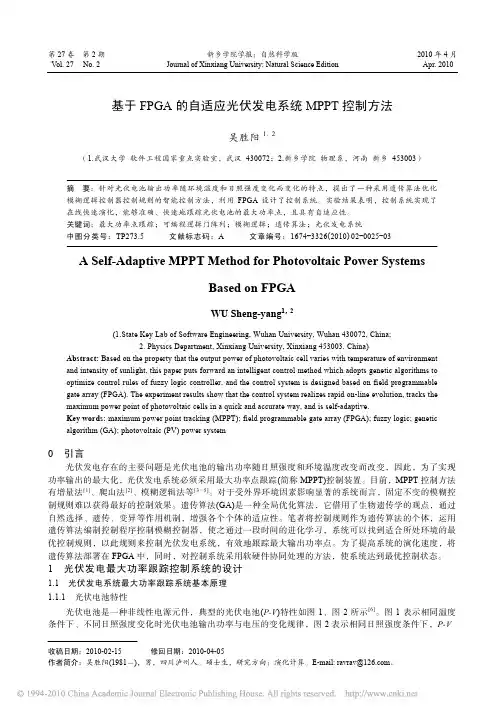
第27卷 第2期新乡学院学报:自然科学版 2010年4月V ol. 27 No. 2 Journal of Xinxiang University: Natural Science Edition Apr. 2010 基于FPGA的自适应光伏发电系统MPPT控制方法吴胜阳1,2(1.武汉大学软件工程国家重点实验室,武汉 430072;2.新乡学院物理系,河南新乡 453003)摘 要:针对光伏电池输出功率随环境温度和日照强度变化而变化的特点,提出了一种采用遗传算法优化模糊逻辑控制器控制规则的智能控制方法,利用FPGA设计了控制系统。
实验结果表明,控制系统实现了在线快速演化,能够准确、快速地跟踪光伏电池的最大功率点,且具有自适应性。
关键词:最大功率点跟踪;可编程逻辑门阵列;模糊逻辑;遗传算法;光伏发电系统中图分类号:TP273.5文献标志码:A文章编号:1674–3326(2010)02–0025–03A Self-Adaptive MPPT Method for Photovoltaic Power SystemsBased on FPGAWU Sheng-yang1,2(1.State Key Lab of Software Engineering, Wuhan University, Wuhan 430072, China;2. Physics Department, Xinxiang University, Xinxiang 453003, China)Abstract: Based on the property that the output power of photovoltaic cell varies with temperature of environment and intensity of sunlight, this paper puts forward an intelligent control method which adopts genetic algorithms to optimize control rules of fuzzy logic controller, and the control system is designed based on field programmable gate array (FPGA). The experiment results show that the control system realizes rapid on-line evolution, tracks the maximum power point of photovoltaic cells in a quick and accurate way, and is self-adaptive.Key words: maximum power point tracking (MPPT); field programmable gate array (FPGA); fuzzy logic; genetic algorithm (GA); photovoltaic (PV) power system0引言光伏发电存在的主要问题是光伏电池的输出功率随日照强度和环境温度改变而改变,因此,为了实现功率输出的最大化,光伏发电系统必须采用最大功率点跟踪(简称MPPT)控制装置。
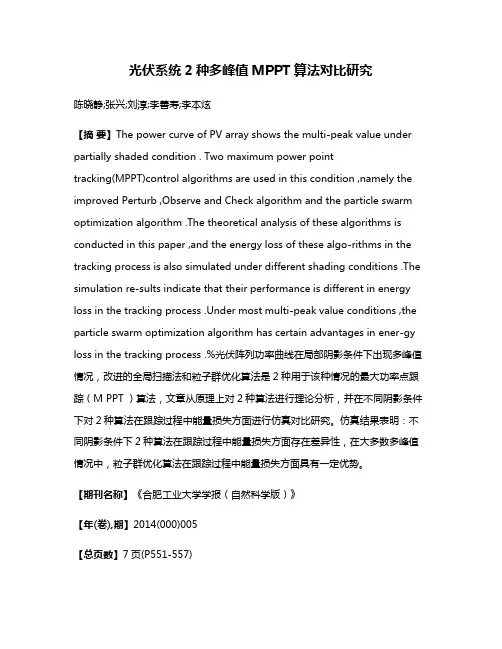
光伏系统2种多峰值MPPT算法对比研究陈晓静;张兴;刘淳;李善寿;李本炫【摘要】The power curve of PV array shows the multi-peak value under partially shaded condition . Two maximum power pointtracking(MPPT)control algorithms are used in this condition ,namely the improved Perturb ,Observe and Check algorithm and the particle swarm optimization algorithm .The theoretical analysis of these algorithms is conducted in this paper ,and the energy loss of these algo-rithms in the tracking process is also simulated under different shading conditions .The simulation re-sults indicate that their performance is different in energy loss in the tracking process .Under most multi-peak value conditions ,the particle swarm optimization algorithm has certain advantages in ener-gy loss in the tracking process .%光伏阵列功率曲线在局部阴影条件下出现多峰值情况,改进的全局扫描法和粒子群优化算法是2种用于该种情况的最大功率点跟踪(M PPT )算法,文章从原理上对2种算法进行理论分析,并在不同阴影条件下对2种算法在跟踪过程中能量损失方面进行仿真对比研究。
上海市崇明区2025年高考诊断性测试英语试题考生请注意:1.答题前请将考场、试室号、座位号、考生号、姓名写在试卷密封线内,不得在试卷上作任何标记。
2.第一部分选择题每小题选出答案后,需将答案写在试卷指定的括号内,第二部分非选择题答案写在试卷题目指定的位置上。
3.考生必须保证答题卡的整洁。
考试结束后,请将本试卷和答题卡一并交回。
第一部分(共20小题,每小题1.5分,满分30分)1.The government has been under growing pressure to ______ the causes of air pollution as smog frequently smothers the country’s large cities.A.release B.scheduleC.maintain D.address2.Parents need to encourage kids to develop their potential _____ putting too much pressure on them.A.without B.besidesC.by D.for3.The event that _________ in my memory happened one morning in 1983 when I was 14 years old. It has never escaped.A.stood out B.stands outC.would stand out D.has stood out4.The shocking news made me realize ________ terrible problems we would face.A.what B.howC.that D.why5.---Do you think Peter is a good partner?--- Not really! There are some things that are not easy to ________ , and his laziness is one.A.put aside B.put up withC.think of D.get along with6.-- Alison, I'm sorry. I can't come to the wedding with you tomorrow morning. -- ________?-- My grandma was severely ill, so I have to stay in the hospital to look after her.A.How is it B.How come C.So what D.What's the problem7.—You were not listening;what troubled you?—I my coming math exam.A.am thinking about B.was thinking about C.had thought about D.will think about8.goes up must come down, and gasoline prices are coming down fast in some parts of America. A.WhereB.WhatC.WhichD.That9.— What great changes have taken place in our city in the last few years!— Indeed, many high buildings have _______all over the city.A.wound up B.sprung up C.held up D.made up10.Much disappointed as he is in the job interview, he still keeps his confidence.A.to have failed B.failedC.having failed D.failing11.The government has taken some measures to solve the shortage of electricity, but it will be some time_________ the situation improves.A.since B.whenC.unless D.before12.If the new safety system _______ to use, the accident would never have happened.A.had been put B.were put C.should be put D.would be put13.---My son is addicted to computer games. He is hopeless,isn't he?---Yes,_____________he is determined to give up and start all over.A.if B.unlessC.though D.so14.— Mary looks hot and dry.— So ________ you if you had a high fever.A.could B.would C.may D.must15.Thanks to Mrs Smith, the father and the son eventually ______after ten years’ cold relationship between them. A.took up B.picked up C.made up D.turned up16.Our dream is to _______ a World Cup that makes you, your grandchildren and everyone in football really proud. A.stage B.chairC.found D.watch17.Last year I applied to Princeton University.I ____ they would say yes—but they did, and now here I am.A.never think B.am never thinkingC.have never thought D.never thought18.I felt like giving up. I probably ________,but my Dad whispered, “Come on! Y ou can make it.”A.would have B.would C.should D.should have19.______ what had happened, they knew I would struggle and simply wanted to help because it was the right thing to do.A.Hearing B.To have heard C.Having heard D.Heard20.Nowadays, more and more Chinese homes have the technology and equipment ______ to do online shopping.A.needed B.needingC.need D.to need第二部分阅读理解(满分40分)阅读下列短文,从每题所给的A、B、C、D四个选项中,选出最佳选项。
光伏发电MPPT的灰色模糊PID控制连瑞娜;熊和金【摘要】The output characteristics of photovoltaic cells are analyzed. According to power-voltage curve of photovoltaic array, on the basis of the existing control algorithm, the gray fuzzy/PID dual-mode control is adopted; that is to say, when it far from the maximum power point because of the changes of external environment or the loads, the fuzzy control is used to track maximum power point(MPP) quickly. For the fuzzy control is the error-control, the fluctuation nearby the MPP is still exist, so when it is nearby MPP, we use PID control to eliminate the error to guarantee the accuracy and reduce energy loss, and the gray-prediction is applied to the MPPT. The simulation results show that the system has good dynamic and steady performances.%分析了光伏电池的输出特性.根据光伏电池的功率-电压曲线,在已有控制算法的基础上,采用灰色模糊/PID双模控制,即在外界环境或者负载发生变化,导致远离最大功率点时,采用模糊控制进行控制,使系统能够快速跟踪到最大功率点.由于模糊控制属于有差控制,在最大功率点附近仍然有震荡,造成一部分功率损失,所以当系统工作在最大功率点的附近时,采用PID控制,以达到一定的控制精度,减少功率的损失,并且将灰色预测应用到光伏发电系统最大功率点跟踪上.仿真结果验证,该控制方法动态、稳态特性良好.【期刊名称】《三峡大学学报(自然科学版)》【年(卷),期】2011(033)001【总页数】4页(P33-36)【关键词】光伏发电;最大功率点跟踪;灰色模糊PID;Matlab【作者】连瑞娜;熊和金【作者单位】武汉理工大学,自动化学院,武汉,430063;武汉理工大学,自动化学院,武汉,430063【正文语种】中文【中图分类】TP273为了充分、高效地利用太阳能,使太阳能尽可能多地输出转变能量,MPPT技术成了光伏发电的关键技术.MPPT控制通常采用DC/DC电路,通过采集光伏电池的输出电压和电流,计算出输出功率,结合控制算法,通过控制DC/DC电路的占空比来控制输出电压从而跟踪到最大功率点.已有的MPPT控制算法有恒定电压跟踪法(CVT)、扰动观测法(P&O)、增量导纳法(INC)等[1],目前国内通常采用CVT法,国外比较常用的有P&O法、INC法.其中CVT法控制简单,易于实现,但是忽略了温度对光伏电池开路电压的影响,所以并不能完全跟踪最大功率点;P&O方法,所需参数少、对传感器精度要求不高,但是其存在最大功率点有震荡,由于天气的变化存在跟踪速度及引起“误判”等问题,INC法虽然能克服“误判”现象,但其控制复杂,对传感器要求较高加上要借助于DSP,增加了费用[2].将灰色模糊/PID控制用于光伏发电的MPPT上,经过Matlab仿真验证其跟踪效果和品质更加良好.1 光伏电池特性光伏电池是一种非线性电源,随着外界环境的变化和负载的变化,其输出也发生变化,通常所用的太阳能电池组件是由许多电池单元串联或者并联起来获得所需要的电压和电流.其中负载电流开路电压光生电流式中,T、G分别为温度和光强,由光伏电池的数学模型可知,其输出电压和电流与温度和光照强度有关,图1为光伏电池在不同光照强度下的功率-电压曲线.图1 光伏电池P-U曲线从光伏电池的P-U特性曲线可知,P-U曲线是单峰曲线,光伏电池在一定的环境条件下只有一个最大功率点,在最大功率点右边输出功率随着输出电压的增大而增大,最大功率点左边则相反,并且最大功率点左右两端的ΔP/Δ U符号不同.2 灰色模糊PID控制的MPPT的实现模糊控制算法是根据人的经验得出的控制规则,不依赖于被控系统精确的数学模型,特别适用于非线性系统.光伏电池就是一种非线性电源,用模糊控制的方法能够解决环境变化时跟踪MPP的速度问题.本文控制原理参考P&O算法,根据图1的P-U 曲线判断距离MPP的远近,在远离最大功率点时采用模糊控制,接近最大功率点时采用PID控制,但是模糊控制是有差控制,在最大功率点仍然存在误差、震荡现象[3],引用PID控制能够有效减轻在最大功率点的震荡,解决跟踪精度问题.由于这些控制都属于事后控制,灰色控制根据已发生的行为特征量预测未发生的事件,属于超前控制、预测控制[4],并且用灰色预测模型的预测值与上一时刻光伏电池的输出值进行比较,比较结果作为模糊控制器或者PID控制器的输入,得出新的输出,灰色模糊PID 的控制原理如图2所示.图2 灰色模糊PID控制框图2.1 模糊控制器的设计2.1.1 确定输入输出量与模糊子集设模糊控制器为双输入单输出的二维控制器,其中输出为DC/DC电路的占空调整步长Δd,输入变量为式中,PV(k)和UV(k)分别指光伏电池第k时刻光伏电池的输出功率和电压,由光伏电池的P-U特性曲线可知,当e(k)=0时,说明光伏电池已工作在最大功率点[5].e(k),Δ e(k)都定义为8个模糊子集分别为{NB, NM,NS,NO,PO,PB,PM,PS},Δd定义为5个模糊子集为{NB,NS,ZO,PB,PS},并将e(k),Δ e(k),Δd的论域分别规定为{-1,1},{-0.5,0.5},{-0.1, 0.1}.2.1.2 确定模糊推理规则本文参考P&O算法原理,通过对P-U曲线的分析得出以下结论,即:(1)当e(k)<0且Δe(k)<0时,P从右侧远离Pmax;(2)当e(k)<0且Δ e(k)>0时,P从右侧向Pmax靠近;(3)当e(k)>0且Δe(k)<0时,P由左侧远离Pmax;(4)当e(k)>0且Δ e(k)>0时,P由左侧向Pmax靠近.根据以上4种情况,确定模糊控制器推理规则,使e(k)始终向零的方向靠近,从而使光伏电池工作在最大功率点.根据以上原理,并且遵循在远离最大功率点时采用较大步长,在最大功率点附近时采用较小步长的原则[6],得出模糊控制规则见表1.表1 模糊控制规则表Δe e NB NM NS NO PO PS PM PB NB NB NB NS NS PS PS PB PB NM NB NB NS NS PS PS PS PB NS NB NS NS ZO ZO PS PS PB NO NS NS NS ZO ZO ZO PS PS PO NS NS ZO ZO ZO ZO PS PS PS NS NS NS ZO ZO PS PS PB PM NB NB NB NS PS PS PS PB PB NB NB NB NS PS PS PB PB2.1.3 确定隶属函数选择常用的三角形作为隶属函数形状,e(k),Δe (k),Δd的隶属函数如图3所示.2.1.4 解模糊通过模糊推理得到的通常是一个模糊集合或者隶属函数,而实际控制中需要一个精确的单值,这个将模糊推理得到的模糊输出变换成精确输出的过程就是解模糊的过程,解模糊的方法有重心法、最大隶属度法、平均法、加权平均法等,在此所采用的解模糊方法是最大值平均法(MOM).MOM法具体为其中Z0为精确输出,Zm是输出隶属函数的最大值时相对应的论域中的第m个元素,M为这种元素的个数.至此光伏发电的MPPT模糊控制器设计完成.2.2 灰色预测的实现灰色系统是指信息部分明确部分不明确的系统,通常采用GM(1,1)单阶单变量模型对系统进行灰预测[7].根据传感器检测的光伏电池Uk-5,Uk-4,Uk-3, Uk-2,Uk-1时刻的输出电压预测Uk,将预测值作为实际输出,得出e(k),Δe(k)和ΔP/Δ U,通过模糊控制器/PID控制器实现控制.具体的预测过程如下.设传感器测得的光伏电池的输出电压列向量为对输出量的原始数据进行累加处理得其中根据U(0)和U(1)得到k+1步预测输出电压为其中式中,u为输出电压的预测值.3 仿真结果根据以上分析,采用Matlab/Simulink对系统进行仿真.其中DC/DC变换电路采用boost升压电路,模糊控制器、PID控制器的切换采用 User Defined Function中的逻辑判断函数根据ΔP/Δ U范围来进行切换[8],根据所选的光伏电池在标准测试条件(t= 25℃,G=1 000 W/m2)设置光伏电池参数:Pmax= 112W,Umax=36.2 V,Imax=3.05 A,Uocs=43.5 V, Iocs=3.28A,Kt=2.06mA/℃,KT=-0.77V/℃.当光照强度在0.25 s从800 W/m2突变到1 000 W/ m2时,仿真结果如图4所示.分析:根据仿真波形,可知在外界环境相对稳定的状态下,即工作于25℃,800 W/m2时,系统稳定的输出功率约为59.8W的功率,当在0.25s,光照突然由800W/m2跃变为1000W/m2时,输出功率基本稳定在最大功率点112 W附近.将灰色模糊PID 控制下的MPPT跟踪效果与模糊控制和模糊PID双模控制下跟踪的稳态误差和精度进行对比,见表2.表2 仿真结果控制方法输出平均功率/W跟踪的相对误差/%模糊控制 108.53.125模糊PID控制 111.6 0.357灰色模糊/PID控制 111.95 0.00454 结论采用灰色模糊/PID控制算法能使系统快速、稳定地响应外界环境的变化,从而减轻了最大功率点附近的震荡造成的功率损失,该控制算法,相对于光伏发电系统中MPPT的其他算法具有更好的动态和稳态性.参考文献:[1] 赵争鸣,刘建政,孙晓瑛,等.太阳能光伏发电及其应用[M].北京:科学出版社,2005.[2] 虞正琦.基于模糊控制的光伏发电系统MPPT技术研究[D].武汉:华中科技大学,2007.[3] 张超,何湘宁.非对称模糊 PID控制在光伏发电MPPT中的应用[J].电工技术报,2005,20(10):72-75.[4] 熊和金,徐华中.灰色控制[M].北京:国防工业出版社, 2005.[5] Katiraei F,Iravani R,Hatziargyriou N,et al.Microgrids Management[J].IEEE Power and Energy M agazine,2008,6(3):54-65.[6] Sera D,Kerekes T,Teodorescu R,et al.Improved MPPT Algorithms for Rapidly Changing Environmental Condition[C].12th International power Electronics and Motion Control Conference,2006:1614-1619.[7] 邹健.智能预测控制及应用研究[D].杭州:浙江大学, 2002.[8] Nicola Femia,Giovanni Petrone,Giovanni Spagnuolo. Optimization of Perturb and Observe Maximum Power Point Tracking Method[J].IEEE Trans on Power E-lectronics,2005,20(4):963-973.。
河南省郑州市外国语中学2025届高三冲刺模拟英语试卷注意事项:1.答题前,考生先将自己的姓名、准考证号填写清楚,将条形码准确粘贴在考生信息条形码粘贴区。
2.选择题必须使用2B铅笔填涂;非选择题必须使用0.5毫米黑色字迹的签字笔书写,字体工整、笔迹清楚。
3.请按照题号顺序在各题目的答题区域内作答,超出答题区域书写的答案无效;在草稿纸、试题卷上答题无效。
4.保持卡面清洁,不要折叠,不要弄破、弄皱,不准使用涂改液、修正带、刮纸刀。
第一部分(共20小题,每小题1.5分,满分30分)1.— Who recommended Nancy for the post?— It was James ______ admiration for her was obvious.A.who B.that C.whose D.whom2.Peter has previous experience, ______ I think he’s the right person for the job.A.or B.butC.for D.so3.Maybe some of you are curiou s about what my life was like on the streets because I’ve never really talked about it______.A.in place B.in turn C.in force D.in depth4.Not until they left school________how much their teachers loved them and helped them.A.they realized B.did they realizedC.the would realized D.had they realized5.There are also people who object to fairy stories on the grounds ______ they are not objectively true, and that giants, witches, two-headed dragons etc do not exist.A.that B.what C.which D.when6.You look beautiful in this dress and there is only one of this kind left here. I wonder if you would buy ________. A.it B.oneC.some D.any7.If it had not been for the heroes’ contributions and sacrifices, we _____such a happy life.A.wouldn’t have led B.wouldn’t be leadingC.haven’t led D.are not leading8.Peterson, a great archaeologist, said: “Archaeologists have been extremely patient because we were led to believe that the ministry was ________ this problem, but we feel that we can't wait any longer.”A.looking out B.bringing out C.carrying out D.sorting out9.What is your main reason for choosing one restaurant another?A.over B.ofC.from D.for10.After the fire,________________ would otherwise be a cultural center is now reduced to a pile of ashes.A.that B.itC.what D.which11.As a child, I was _________to keep quiet when my parents were discussing something, while parents nowadays often ask for their children’s opinions.A.demanded B.hoped C.forbidden D.required12.After making the speech, he went through it in his mind to reflect where he_________ better.A.could do B.would do C.could have done D.would have done13.Despite the obvious privacy concerns, the use of facial-recognition technology is ________ at some public places. A.out of danger B.on the run C.out of sight D.on the rise14.Some warned that the step the US government has taken to cope with the current crisis is ________ much risk. A.one of B.the one of C.the one D.that one15.By doing so, you can ________ more information and details about the topic, and better understand it.A.keep up with B.do away withC.have access to D.get down to16.Is it he or you ________ in charge of the job and supposed to complete it punctually?A.who is B.that isC.who are D.whom are17.The conference aims to develop business and let people think about _______ they can have a positive influence on the planet.A.why B.thatC.what D.how18.— Tell me something about his match in Sydney.— Well,he got the championship,we had expected.He made it at last.A.as B.what C.why D.how19.—Ted has never been so rude!—He ______something he shouldn’t have, but I guess he didn’t mean that.A.has said B.had saidC.said D.was saying20.The kid is crying, for he ______ jump over the ditch on his own.A.dares not to B.dare not to C.doesn’t dare to D.dares not第二部分阅读理解(满分40分)阅读下列短文,从每题所给的A、B、C、D四个选项中,选出最佳选项。
基于差分进化算法的阴影影响下光伏阵列MPPT控制研究林祺蓉;王俏俏;林祺蔚;林琳;董晨晖;刘红霞【摘要】当光伏模块受到阴影影响时,其功率-电压(P-V)特性曲线有多个峰值点,传统最大功率跟踪控制(MPPT)算法,如扰动观察法(P&0),由于采用局部搜索范围,无法准确跟踪全局最大功率点(GMPP).提出一种基于差分进化(DE)最优算法的全局最大功率点跟踪方法,同时修正了算法的变异方向,使得所有变异算子总能收敛到最优,有助于算法快速收敛.采用Matlab/Simulink对所述算法进行了仿真分析,并与传统扰动观察法进行了对比,本文所述MPPT方法具有更高的效率和功率输出.【期刊名称】《中国电力》【年(卷),期】2015(048)006【总页数】6页(P39-44)【关键词】光伏阵列;部分阴影;差分进化算法;最大功率点跟踪;全局最大功率点【作者】林祺蓉;王俏俏;林祺蔚;林琳;董晨晖;刘红霞【作者单位】国网济南供电公司,山东济南 250012;国网济南供电公司,山东济南250012;国网济南供电公司,山东济南 250012;国网济南供电公司,山东济南250012;国网济南供电公司,山东济南 250012;国网济南供电公司,山东济南250012【正文语种】中文【中图分类】TM614由于发电过程中零污染、无噪音,光伏发电系统近年来在全球范围内得到快速发展[1]。
我国自20世纪70年代光伏发电产业起步,20世纪90年代已经进入快速发展时期,至2011年中国光伏产业产能达30 GW,产业规模跃居世界第一[2],2013年光伏组件产量达到27 GW,占全球光伏产量的60%以上[3]。
PV模块功率输出主要依赖于光照强度,为了获取最大功率输出,需要进行最大功率点跟踪(MPPT)[4-5]。
近年来,国内外学者提出了多种最大功率点跟踪方法,包括分数开路电压法、分数短路电流法、电导增量法、模糊逻辑控制、扰动观察法以及中性点网络法等[6-13]。
快速退火化遗传MPPT算法的研究陈宇宏;张文生;刘航【摘要】In the photovoltaic system,MPPT (Maximum Power Point Tracking) step is a very important loop and the MPPT algorithms have a decisive effect on the efficiency of MPPT output.The genetic algorithms overcome the problem of convergence too early and increase the speed of seek by searching solar panels array and Boost circuit to set up the MATLAB ' s simulation model and analyze each loop' s optimizing formula of fast annealing algorithms,and bring it in genetic algorithms to deal with each individual of population.%在光伏系统中,最大功率点跟踪(MPPT)是十分重要的环节,而MPPT算法对MPPT输出的效率具有决定性作用.通过对光伏电池板方阵和Boost电路的研究建立起MATLAB仿真模型,然后分析了快速退火算法的各个环节优化公式,并将其引入遗传算法中,用其处理种群个体.使遗传算法克服了过早收敛的问题,并加快了算法的搜索速度,最终实现MPPT功能.【期刊名称】《电气自动化》【年(卷),期】2013(035)004【总页数】3页(P31-33)【关键词】快速退火算法;遗传算法;最大功率点跟踪;光伏电池板方阵;Boost电路【作者】陈宇宏;张文生;刘航【作者单位】辽宁工业大学电子与信息工程学院,辽宁锦州 121001;辽宁工业大学电子与信息工程学院,辽宁锦州 121001;辽宁工业大学电子与信息工程学院,辽宁锦州 121001【正文语种】中文【中图分类】TM6150 引言电子技术的发展推动着能源技术的发展,而在众多的能源技术中,光伏发电具有许多其他能源所不具有的优势。
矿产资源开发利用方案编写内容要求及审查大纲
矿产资源开发利用方案编写内容要求及《矿产资源开发利用方案》审查大纲一、概述
㈠矿区位置、隶属关系和企业性质。
如为改扩建矿山, 应说明矿山现状、
特点及存在的主要问题。
㈡编制依据
(1简述项目前期工作进展情况及与有关方面对项目的意向性协议情况。
(2 列出开发利用方案编制所依据的主要基础性资料的名称。
如经储量管理部门认定的矿区地质勘探报告、选矿试验报告、加工利用试验报告、工程地质初评资料、矿区水文资料和供水资料等。
对改、扩建矿山应有生产实际资料, 如矿山总平面现状图、矿床开拓系统图、采场现状图和主要采选设备清单等。
二、矿产品需求现状和预测
㈠该矿产在国内需求情况和市场供应情况
1、矿产品现状及加工利用趋向。
2、国内近、远期的需求量及主要销向预测。
㈡产品价格分析
1、国内矿产品价格现状。
2、矿产品价格稳定性及变化趋势。
三、矿产资源概况
㈠矿区总体概况
1、矿区总体规划情况。
2、矿区矿产资源概况。
3、该设计与矿区总体开发的关系。
㈡该设计项目的资源概况
1、矿床地质及构造特征。
2、矿床开采技术条件及水文地质条件。